A Lesson in Safety: Salt Walther’s Race Car

The mangled wreck of driver David “Salt” Walther’s 1972 McLaren M16A is on exhibit in Driven to Win: Racing in America in Henry Ford Museum of American Innovation.
Search the 1973 Indianapolis 500 on the Internet, and you won’t find a bunch of happy headlines. Words like “fatal,” “tragedy,” “cursed,” and “unforgettable” pop up.
Three deaths and multiple crashes are attached to the ill-fated race. One of the day’s most dramatic headlines, and still considered one of the worst crashes in Indy 500 history, involved driver David “Salt” Walther and his 1972 McLaren M16A, an artifact on display in Driven to Win: Racing in America in Henry Ford Museum of American Innovation.
On the race’s first lap, Walther’s car crashed into the outside wall, exploded, and overturned. Images of the ripped-apart vehicle with Walther’s feet dangling outside of it are disturbing, but although badly burned, Walther did survive the accident. Miraculously, he didn’t lose his passion for auto racing either, coming back to the sport to drive again in 1974. In fact, Walther started in seven Indianapolis 500s, five of which occurred after his terrible crash (his best finish was ninth place in 1976).
Continue Reading
Indiana, 20th century, 1970s, The Henry Ford Magazine, racing, race cars, race car drivers, Indy 500, Henry Ford Museum, Driven to Win, cars
Exploring the Origins of Idioms
Language helps fulfill the human need to be understood, but what happens when you can’t find the precise word to express yourself? When one word just doesn’t do justice to the situation or emotion you are trying to convey? In these circumstances, we often turn to figurative language, like metaphors, hyperbole, or symbolism. These non-literal tools give our speech and writing color, drama, and often a specificity that is hard to achieve with more direct language.
One such linguistic tool is so frequently used that it tends to “fly under the radar.” An idiom is a non-literal expression whose meaning cannot be deduced from the true meaning of its individual words. It comes to have its own meaning. But the concept is more easily understood by examples of its usage—like “raining cats and dogs,” “grab the bull by the horns,” “get cold feet,” or “cost an arm and a leg.” These phrases only make sense because of our association with them. Today, taken literally, they have no understandable meaning. However, when they were first used, the situation described would have been familiar enough with others to resonate and repeat.
Idioms are democratic. Although perhaps invented by one person, that one person cannot force an idiom into the lexicon. The expression has to connect with enough people to gain momentum and spread. Eventually, the idiom’s origin story is often forgotten, divorced from the expression—and yet, sometimes, the idiom and the expression it conveys remain.
Above all, the persistence of idioms demonstrates that the words we use matter. They attest to our need for connection—their precision allows for shared experience or shared understanding. Idioms both evidence and activate human imagination.
A survey of The Henry Ford’s collection reveals idioms in every corner. Certain objects inspired or played a role in the origin stories of idioms. Other objects integrate idioms, and still others serve to illustrate them.
Mad as a Hatter
Someone who is behaving unpredictably; insane
Top Hat, 1830-1860 / THF301599
Hatmakers from the 18th through early 20th centuries used the toxic substance formally named mercurous nitrate to turn an animal hide into the felt used to make hats, especially top hats. Mercury is a cumulative poison—the longer and more often one is exposed, the more it builds, and symptoms worsen. Prolonged exposure can cause mood swings, loss of coordination, memory loss, paranoia, and erratic behavior. Many hatmakers experienced the symptoms of acute mercury poisoning—but were thought to have gone insane or “mad as a hatter.” By late December 1941, the use of mercury in the felt industry was banned by the United States Public Health Service, but the concept of a “mad hatter” was properly solidified in the English vernacular.
Lewis Carroll’s novel Alice’s Adventures in Wonderland, published in 1865, popularized the caricature in the portrayal of the Hatter. By the time Carroll wrote the novel, the idiom was in common use.
Fly by the Seat of Your Pants
To improvise by instinct
Agnes Firth in a Caudron Airplane, 1911-1912 / THF255259
Prior to the widespread use of reliable aviation instruments, pilots were at the mercy of the weather. Assessment of cloud cover and potential storms were vital in the early days of flying, when encapsulation of an aircraft by thick cloud or dense fog could have fatal consequences. The thin air and inability to see could become disorienting. When overtaken by rough conditions, a skilled pilot would “fly by the seat of their pants.” They flew by instinct and feel—and their backside, or the seat of their pants, made the most physical contact with the airplane.
The Time Is Ripe
It is the most favorable time
Protest Poster, "The Time is Always Ripe to Do Right –Martin Luther King, Jr.," 2020 / THF610242
Perhaps unsurprisingly, this idiom has agricultural roots. While substituting “right” for “ripe” maintains the meaning of the expression, there is a loss of specificity that the idiom allows. For example, when an apple is perfectly ripe, it is sweet with a satisfying crunch. When it passes peak ripeness, it begins to rot. The sweetness becomes cloying, and the crunch turns to mush. Moreover, one rotten apple begets another and another. As poet Geoffrey Chaucer wrote, “A rotten apple’s better thrown away before it spoils the barrel.” “The time is ripe” implies that not only is the time right, but that it is the perfect time—and that waiting has consequences.
This famous quote by Martin Luther King, Jr., was printed on a protest poster following the brutal murder of George Floyd by police in May 2020. King used the idiom to promote urgency in a 1968 speech at the National Cathedral in Washington, D.C., “Remaining Awake Through a Great Revolution”:
“It may well be that we will have to repent in this generation. Not merely for the vitriolic words and the violent actions of the bad people, but for the appalling silence and indifference of the good people who sit around and say, ‘Wait on time.’ Somewhere we must come to see that human progress never rolls in on the wheels of inevitability. It comes through the tireless efforts and the persistent work of dedicated individuals who are willing to be co-workers with God. And without this hard work, time itself becomes an ally of the primitive forces of social stagnation. So we must help time and realize that the time is always ripe to do right [emphasis added].”
Burning the Midnight Oil
To work late into the night
Pewter Oil Lamp, 1842-1847 / THF153606
Before the invention of gas-powered lamps (or later, electricity), candles or oil lamps were used to illuminate the darkness. Poet Francis Quarles refers to “mid-night oil” in Emblem II of his 1635 book Emblemes:
“We spend our mid-day sweat, our mid-night oil,
We tire the night in thought; the day in toil.”
College students today might “burn the midnight oil” while “pulling an all-nighter.” Although oil lamps were superseded by kerosene lamps in the 19th century, and then by electricity in the 20th, the expression remains in use, but may be well on its way to obsolescence.
Break the Ice/Ice-Breaker
To prepare the way; to do something to relieve tension
U.S.S. Eagles 1 and 2 in Ice at Entrance to White Sea, Bound for Arkhangelsk, 1919 / THF270358
A still-relevant, centuries-old idiom is “break the ice” or “ice-breaker.” Referring originally to the physical breakage of the frozen surface of a body of water to allow a boat’s passage, it quickly became a resonating figurative expression, seemingly ready-made for its idiomatic use. The phrase has become a favorite of authors and playwrights, used from the 16th century up to the present. Nowadays, “ice breakers”—in the form of a personal question or group activity—are often used at the start of a class or meeting to relieve nerves and get participants involved.
Handle with Kid Gloves
To deal with a situation gently or carefully
Ladies Leather Gloves, 1920-1930 / THF102566
Some of the finest leather gloves are made of kidskin or kid leather—made from the hide of a young goat, called a “kid.” Kid leather is especially soft and thin, so the wearer of kid gloves must handle objects carefully so as not to scratch or rip the leather. To “handle with kid gloves” means to handle a situation carefully, as one would if wearing fine, fragile gloves.
Make the Grade
To succeed
Allegheny Steam Locomotive, 1941 / THF134572
Standing next to the Allegheny steam locomotive in Henry Ford Museum of American Innovation, you can almost feel its physical power—even when static, unmoving. The Chesapeake & Ohio Railway’s Allegheny steam locomotives were incredibly powerful, featuring an output of 7,500 horsepower. They were designed to pull heavy, loaded coal trains up and over the Allegheny Mountains. These trains had a steep climb to the summit, but the 771,000-pound giants had enough traction to “make the grade.”
Although many people queried today might point to academics as the origin of the idiom “make the grade,” the phrase comes from a train’s ability to successfully climb a hill—or gradient.
Surf the Net/Net Surfer
To move quickly from webpage to webpage
Internet: A First Discovery Book, 2000 / THF627799
A librarian is to be credited with the perfect ‘90s slang idiom: “surf the net.” Jean Armour Polly was one of the first librarians to prioritize free Internet access in a public library setting. An assistant librarian in 1981, Polly advocated for the Liverpool Public Library of Liverpool, NY, to make computer and Internet access available to the library’s patrons. She faced backlash from traditional librarians who saw the Internet as a threat to books and other printed matter, but worked to convince others that the Internet could be a resource for learning.
Polly’s 1992 guide for a library journal, titled “Surfing the Internet: An introduction,” used surfing as a metaphor for using the internet. She recalled that she felt it appropriate because, “It’s hard. You need some skill. You never know if there are going to be sharks.” The phrase “surfing the net” quickly caught on and spawned variations, like “net surfer.”
She later wrote a book—Net-mom’s Internet Kids & Family Yellow Pages—which became a best-selling resource for families looking to provide fun and safe educational internet access for children. In 2019, Polly was inducted into the Internet Hall of Fame.
Eye Candy
Superficially attractive
"Patterns of Thought: Eye Candy" by Ginny Ruffner and Steve Kursh, 1994 / THF164911
Glass artist Ginny Ruffner was in serious car accident in 1991. She awoke after weeks in a coma, but was partially paralyzed and suffered significant memory loss—including about her own identity. She recalled, “I was terrified. My mind was like a big empty house that you knew you used to live in." In order to stimulate her memory, friends—fellow studio glass artists—sent Ruffner a bouquet of “eye candy”—blown glass orbs of brilliant color and pattern, individually crafted by her friends and loved ones. This eye candy surely would have stimulated Ruffner’s spirit as well as her memory.
Ruffner eventually made miraculous improvements and just a year later, was back at work creating glass sculpture, persevering through vision issues, lingering paralysis in her dominant hand, and the challenges of being confined to a wheelchair.
The idiom “eye candy” is often used today to describe a superficially attractive person or object. This use of “eye candy” is a slightly more literal use of the non-literal phrase—the orbs look like pieces of candy in a dish, but for your eyes! Also, the meaning of “superficial” here may refer to its definition of “occurring at the surface.” These blown glass orbs are only attractive at the surface because, of course, nothing lies beneath the surface—just air.
Katherine White is Associate Curator at The Henry Ford.
Lincoln’s Century with Ford Motor Company

1928 Lincoln Four-Passenger Coupe Advertising Proof, "Every Lincoln Body is a Custom Creation of Some Master Body Builder" / THF113063
One hundred years ago this month, Henry Ford purchased the Lincoln Motor Company from Henry Leland. The Henry Ford joined in the centennial celebration on our website, where we published a new Popular Research Topic outlining key Lincoln assets from our collections; on Facebook and Twitter, where we shared social posts featuring artifacts from our collections; and on Instagram, where Reference Archivist Kathy Makas shared a Lincoln-related story. Kathy’s story was part of our History Outside the Box monthly series on Instagram, featuring interesting or noteworthy items from our archives.
If you missed the live version of our Instagram story, you can check it out below to learn how Edsel Ford, as president of Lincoln, brought a design eye to the company and how design at Lincoln evolved. You’ll also discover a few of the famous celebrities who owned Lincolns, take a look at some Lincoln publications, and more.
Continue Reading
Ford family, History Outside the Box, Ford Motor Company, Edsel Ford, design, cars, by Kathy Makas, by Ellice Engdahl
Crispus Attucks and Evolving Perceptions of the Boston Massacre
 “The Bloody Massacre,” 1770, engraved by Paul Revere and hand-colored by Christian Remick. / THF8141
“The Bloody Massacre,” 1770, engraved by Paul Revere and hand-colored by Christian Remick. / THF8141On March 5, 1770, in King Street in Boston, Massachusetts, several British soldiers fired into an angry group of civilians who had been taunting them. When the shooting was over, five of these civilians lay dead or dying. The first to fall, it is believed, was a man of African American and Native American heritage named Crispus Attucks.
The event, which soon became known as the Bloody Massacre, or—over time—the Boston Massacre, incensed Bostonians to such an extent that it came to be considered a defining moment in the lead-up to the American Revolution.
The more than 200 eyewitness accounts that were collected afterward agreed on some points but disagreed on many others. In the end, we have only impressions, fragments, and often competing narratives of what people remembered seeing. The sequence of events might have gone something like this: The initial angered group approached a guard in front of the Customs House and started insulting him and pelting him with snowballs and chunks of ice. The situation quickly escalated as the crowd grew larger. The guard called for reinforcements. Other British soldiers, including a captain, arrived. More townspeople joined in, throwing snowballs and insults at the troops. A soldier was knocked to the ground. He stood up, yelled, and fired his musket into the crowd. Then several other soldiers fired their weapons, killing three and mortally wounding two others.
Perhaps this is the sequence of events. We will never know for sure.
Whatever people thought they saw, almost immediately the popular press took full advantage, describing the event in endless detail and hailing the fallen victims as martyrs in the fight for liberty. Even the use of the word “massacre” implied a premeditated, cold-blooded, intentional act by British soldiers against American patriots.
This event did not occur in isolation but was an outgrowth of months of increasing tension between the British and Boston civilians, who were angered by the relentless passage of new British-imposed taxation laws. In 1768, British soldiers had been deployed to Boston to try to maintain order there.

“A View of Part of the Town of Boston in New-England and British Ships of War Landing Their Troops!” 1768, engraved by Paul Revere and hand-colored by Christian Remick. / THF11644
In fact, the angry individuals who had initially taunted the soldiers were not patriotic Sons of Liberty but working-class day laborers, apprentices, and merchant sailors. These individuals had a particularly personal gripe against the British soldiers: the soldiers, who were poorly paid, often competed with them for jobs, and this competition inevitably led to lowered wages.
In the end, it didn’t matter that the initial crowd who started the fracas was motivated more by economic reasons (jobs, wages) than ideological ones (liberty, independence). Nor did it matter that John Adams’ brilliant defense of the soldiers eight months later in court played to the jury’s prejudices against race and class by labeling the angry crowd as an unruly mob of young, lower-class, Black and Irish sailors. Bostonians were riled up. And the fact that all but two soldiers were acquitted at the end of their murder trial further inflamed them.

Engraving of “The Bloody Massacre,” created about 1800 from the original 1770 Paul Revere print, showing a clearer depiction of the Butcher’s Hall sign than the hand-colored lithograph shown at the beginning of this post. / THF130817
One Boston patriot, engraver Paul Revere, decided to use this event to make a larger political statement (for more on Paul Revere, see “Paul Revere and The Henry Ford's Tie to Tea”). Basing his engraving upon an as-yet-unpublished rendering created by artist Henry Pelham, Revere was able to complete his own engraving ahead of Pelham’s and start disseminating a mere three weeks after the event. He gave it the dramatic title, “The Bloody Massacre: Perpetrated in King Street, Boston on March 5, 1770, by a party of the 29th Regt.” This title ensured that the focus would be on the shooting, the place, and particularly on the “guilty”—i.e., the soldiers.
Revere cleverly heightened other details to make certain points—the orderly lineup of British soldiers firing into the American crowd, their actions depicted as brutal and deliberate; the colonists dressed as gentlemen rather than laborers, their behavior seen as innocent and defenseless; and, above the soldiers’ heads, a sign reading “Butcher’s Hall,” rather than the actual Customs House, to underscore the goriness of the event. All of these details—and more—were, in fact, inaccurate and misleading. But they certainly shaped public opinion. The narrative told within this print would endure for centuries—even to the present day. It was possibly the most effective piece of war propaganda in American history.
Noticeably absent in Paul Revere’s engraving is the aforementioned Crispus Attucks—generally thought to be the first casualty of the Boston Massacre. The reason for this? Likely, depicting a mixed-race, working class, itinerant sailor from out of town would not have played to the public sentiment that Revere was aiming for. Only later did Attucks emerge as the most famous of the five victims of the Boston Massacre.
What do we know about Crispus Attucks? Admittedly, not much. Historians believe he was born of an enslaved African American father and a Native American mother. He spent his early life enslaved to a man in Framingham, Massachusetts. At age 27, it is believed, he ran away (about 20 years before the Boston Massacre) and was never apprehended (he might have changed his name to avoid detection). An ad for a runaway slave that was possibly Attucks described him as 6’2”, with short, curly hair and a robust physique.
He apparently made his way to Boston, where he sought work as a sailor (one of the few trades open to non-whites), spending most of his time on whaling ships, and when on land, was a rope-maker (a typical dockside job for sailors). He was often at sea, and on this particular day, March 5, 1770, he was waiting for an opportunity to ship out. Not only could his anger at the British soldiers have been due to job competition, but he, like other merchant sailors, also faced the danger of being forcibly impressed into the British Royal Navy (for more on the lives and risks of African American merchant seamen, see “Piecing Together Black History: A Case Study”).
Accounts vary widely as to Attucks’ role in the Boston Massacre. Was he a leader and instigator of the angry crowd, as some claimed? Did he step into the fray, swinging a stick and grabbing a soldier’s bayonet, as others described? In defending the British soldiers, John Adams sought to distance Attucks (and the other so-called “rabble-rousers”) from the upstanding, respectable, solid citizenry of Boston. He described Attucks’ behavior as “mad” and declared him the self-appointed leader, chief to blame for the “dreadful carnage.” Other testimonies claimed he was not the leader or an instigator, but stood off to the side, watching the melee unfold. Rather than angrily wielding a stick, he was quietly leaning on one.
Most people at the time considered him—along with the other fallen victims—a martyr, a hero. Breaking with usual segregation customs, Attucks was accorded an honored burial alongside his fallen comrades at the Granary Burying Ground on Tremont Street. Burial rites for the victims, held at Faneuil Hall days later, reportedly attracted some 10,000 of Boston’s 16,000 citizens.

When seen through a special viewer, the two pictures in this stereograph give a three-dimensional effect. This circa 1859 stereograph is of Faneuil Hall, the public meeting hall that was the site of the burial rites for the Boston Massacre victims back in 1770. / THF278882
Several decades later, Attucks was recast as the central figure of the conflict. During the decades before the Civil War, anti-slavery advocates memorialized him in order to garner support to end slavery—calling him the first martyr in the fight for American independence.

The anti-slavery press, centered in northern states like New York and Massachusetts, produced and sold almanacs like this one that featured provocative cover illustrations depicting the brutality of slavery. / THF7209
In 1855, in direct contrast to Revere’s earlier engraving, artist William L. Champney featured Attucks in a brand-new rendering of the Boston Massacre, placing him at the very center of the conflict. The rendering was turned into a popular color print by J. H. Bufford.
In 1888, a monument (still standing today) was unveiled in Boston Common honoring all five victims of the massacre, but it focused attention on Attucks and was ever after referred to as the Crispus Attucks Monument. During the Civil Rights movement of the 1950s–1960s, Attucks became a powerful symbol of African Americans’ struggle for freedom and equality. In his seminal 1964 book Why We Can’t Wait, the Reverend Dr. Martin Luther King, Jr. reinforced the symbolic role of Crispus Attucks:
He is one of the most important figures in African-American history, not for what he did for his own race but for what he did for all oppressed people everywhere. He is a reminder that the African-American heritage is not only African but American and it is a heritage that begins with the beginning of America.

Cover of Dr. Martin Luther King’s 1964 book, which contains the reference to Crispus Attucks. / THF266487
In recent years, Attucks’ role in the Boston Massacre has been reimagined again, this time as the first African American victim of unrestrained police brutality.
The role that Crispus Attucks played in this event was debated from the beginning. Was he the leader of an unruly mob angry about jobs? Was he a hero and a martyr, fighting for liberty? In fact, his most important role may be that of showing how perceptions of individuals can change over time. As historians and curators continue to sift through the documented details about the Boston Massacre, interpretations will change. But the power of this dramatic event, and the meaning people find within it, will endure.
Donna R. Braden is Senior Curator and Curator of Public Life at The Henry Ford. This blog post is part of a series that sheds new light on stories told within the With Liberty & Justice for All exhibition in Henry Ford Museum of American Innovation.
African American history, Henry Ford Museum, by Donna R. Braden
The History of Historic Base Ball in Greenfield Village
In 1993, inspired by a handful of century-old newspaper references, nine employees volunteered to form The Henry Ford’s first historic base ball club. What started small has become a grand and beloved Greenfield Village tradition, guided—as it was from the beginning—by a passion for authenticity.
The Greenfield Village Lah-De-Dahs and the general store that spurred the club’s formation, 1994. / THF136301
Beginnings
It all began with Greenfield Village’s general store. New research in the 1990s initiated a more accurate historical interpretation of the J.R. Jones General Store as it existed in Waterford, Michigan, during the 1880s. It also turned up references to a local amateur base ball club—the Lah-De-Dahs—in period newspapers. Employees eagerly set about reviving the Lah-De-Dahs as a historic base ball club. A clue about the original uniform came from a colorful report on the Lah-De-Dahs’ poor showing in a summer 1887 game:
As the contest went on, slowly but surely dawned upon the minds of all the truth that a fine uniform does not constitute a fine pitcher, nor La-de-dahs in their mammas’ red stockings make swift, unerring fielders. —Pontiac Bill Poster, September 14, 1887
The revived Lah-De-Dahs of Greenfield Village wore white base ball shirts with a red script “L” and, at first, nondescript white painter’s pants. (The Henry Ford’s period clothing studio soon produced matching, knickers-style bottoms.) That first season, the Lah-De-Dahs played a handful of matches with rules pieced together from various historical interpretations. At Firestone Farm, the club challenged farmhands in the harvested wheat field before whatever crowd gathered along the lane. The Lah-De-Dahs also hosted a few outside historic base ball clubs at their future home field, Walnut Grove.
Structure
Historic base ball in Greenfield Village quickly assumed a more structured form that incorporated thoughtful details rooted in history—beginning with the name of the sport itself. Virtually all of the earliest references to this style of bat-and-ball game in England and the United States used the hyphenated name, “base-ball.” By the late 1830s and into the 1840s, likely due to simple changes in typesetting practices, the two-word spelling, "base ball," had begun to replace "base-ball." Conventions continued to shift, with the hyphenated version reemerging in the mid-late 19th century and receiving formal backing from the U.S. Government Printing Office in 1896. But years earlier, in 1884, the New York Times had explicitly changed its style guide away from "base-ball" to "baseball"—an early move toward the one-word convention that would stick. To highlight overlapping customs in the sport’s formative decades, The Henry Ford emphasizes the two-word spelling in its historic base ball program.
Henry Chadwick’s 1867 Base Ball Player's Book of Reference, the first reference book designed to teach the game of base ball, from which the current rules of play in Greenfield Village were drawn. / THF214794
For demonstration in Greenfield Village outside of Lah-De-Dahs matches, a set of rules, known as “Town Ball” or “Massachusetts Rules,” was selected from the 1860 Beadle’s Dime Base Ball Player. Written by Henry Chadwick, a sports journalist and leading promoter of base ball, this book included early rules of the game we know today, as well as the alternative “Massachusetts Rules” version of the game. This early version of baseball requires minimal equipment, calls for a soft ball, and features chaotic rules, making it a perfect choice for guests of Greenfield Village to try.
Elements added for the comfort and enjoyment of spectators on Walnut Grove appropriately reflect the 1860s setting. On select dates, the Dodworth Saxhorn Band provides musical accompaniment representing that of a period brass band. (Much of the music commonly associated with the professional game of baseball in America—including its unofficial anthem, “Take Me Out to the Ball Game”—was published two generations later.) Refreshments are served from contextual, temporary structures fitting the rural environments where 1860s base ball was played. And a uniquely designed sound system—disguised by several strategically placed waste receptacles—allows the umpire and scorekeeper to present a real-time account of the game via concealed cordless microphones. The live music and play-by-play, combined with the unpredictability of the game, make for an entertaining afternoon.
The Dodworth Saxhorn Band during the World Tournament of Historic Base Ball, 2007, photographed by Michelle Andonian. / THF52297
Expansion
The Lah-De-Dahs’ roster grew to 25 players over the club’s second and third seasons. They wore handmade uniforms for matches, which were held whenever visiting clubs could make the trip to Greenfield Village. By 2002, the season consisted of a dozen games played on select Saturdays throughout the summer. After nearly a decade of play, the Lah-De-Dahs had attracted a dedicated fan base, and spectators increasingly requested a regular schedule with more games.
The reopening of Greenfield Village in 2003 after a massive restoration project heightened expectations for the historic base ball program. With financial support from Edsel and Cynthia Ford, The Henry Ford delivered an entire summer of base ball with expanded offerings: daily period base ball demonstrations, formal games on Saturdays and Sundays—now played by the “New York rules” specified in Henry Chadwick’s 1867 Base Ball Player's Book of Reference (which were more familiar to spectators than the Massachusetts Rules game)—and the development of the World Tournament of Historic Base Ball.
The Henry Ford’s World Tournament of Historic Base Ball pays homage to the original “World's Tournament of Base Ball” hosted in August 1867 by the Detroit Base Ball Club. Though organizers ultimately failed to attract the world-famous clubs of the day, they managed to stage a remarkable, one-of-a-kind event. The trophy bat awarded to the Unknown Base Ball Club of Jackson, Michigan—winners of the first-class division of the 1867 tournament—is now in The Henry Ford’s collections. It is displayed each year in Greenfield Village during the World Tournament of Historic Base Ball.

Trophy bat awarded at the 1867 World's Tournament of Base Ball. / THF8654
For 2004, the Lah-De-Dahs’ season expanded from 12 to 30 games, and its roster swelled to 42 players. To make sure they always had an opponent, The Henry Ford created a second club. The National Base Ball Club takes its name from a competitor in the 1867 World's Tournament of Base Ball. New uniforms purchased for both clubs added to the already vibrant atmosphere during matches, with the Lah-De-Dahs in their now-familiar red and white and the Nationals in striking dark blue and gold. At first, many considered the Lah-De-Dahs to be Greenfield Village’s “home” club, but displays of sportsmanship and close games going to either side have endeared fans to both.

One of the close plays that have helped endear fans to both Greenfield Village clubs.
Over time, baseball became “America’s pastime,” an enduring cultural touchstone—and a multibillion-dollar business. Historic Base Ball in Greenfield Village (and also played in many other venues around the country) showcases an early form of the sport, from a time when amateurs played for recreation and innocent amusement—for the love of the game!
Brian James Egen is Executive Producer and Head of Studio Productions at The Henry Ford and Marcus W. Dickson is Professor of Industrial/Organizational Psychology at Wayne State University. This post was prepared for the blog by Saige Jedele, Associate Curator, Digital Content, at The Henry Ford.
Additional Readings:
research, Historic Base Ball, by Saige Jedele, by Marcus Dickson, by Brian James Egen, #Behind The Scenes @ The Henry Ford, Greenfield Village, events, sports, baseball
Quiet & Loud Protest
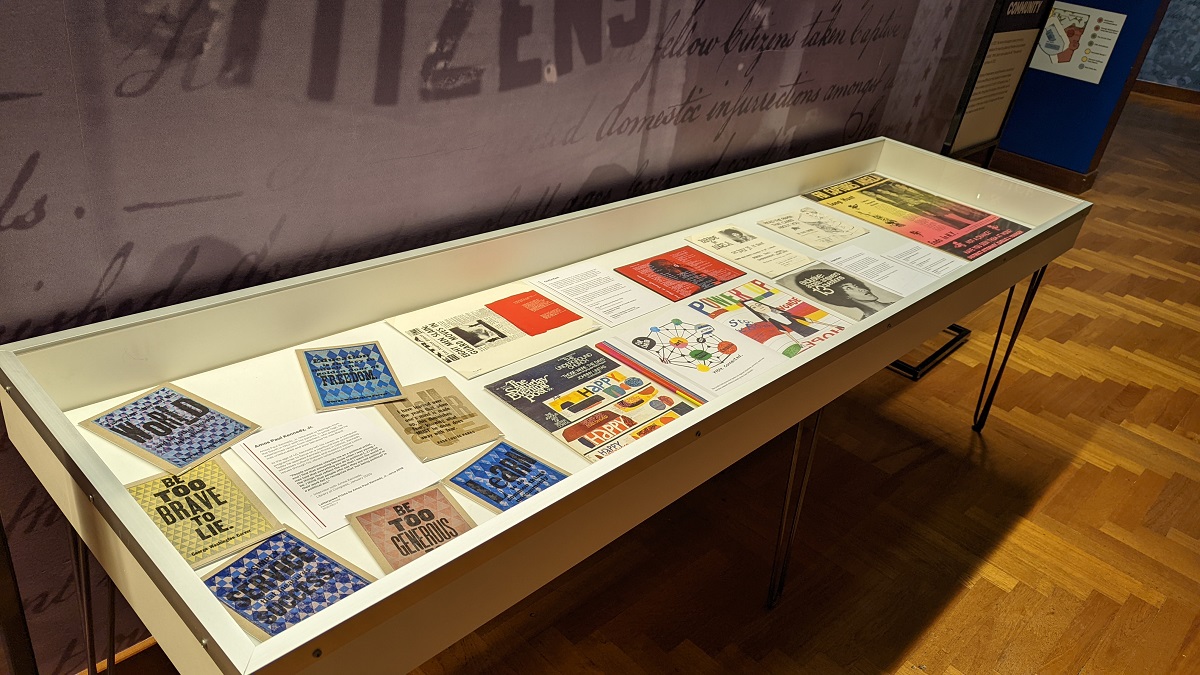
Photo by Curatorial Staff of The Henry Ford
When you think of the word “protest,” what does it mean to you?
- Marching at a rally with a sign?
- Participating in a “walk out” at school?
- Boycotting companies?
- Wearing a shirt or hat with a message?
- Correcting people on their biases?
- Donating money to organizations?
- Civil disobedience?
A new temporary exhibit now on view in Henry Ford Museum of American Innovation, Quiet & Loud Protest, explores this question by demonstrating the ways that protest can be both loud and quiet. Throughout history, people have found different ways to advocate for change, whether marching in the streets or finding quieter ways to be an ally. Both are valuable in drawing attention to injustices. The exhibit draws together a small selection of recent acquisitions that showcase how artist-activists have used graphics to demand change and organize communities. The content of the exhibition is replicated in this post (with slightly expanded descriptions) for those unable to see it in person.
Amos Paul Kennedy, Jr.
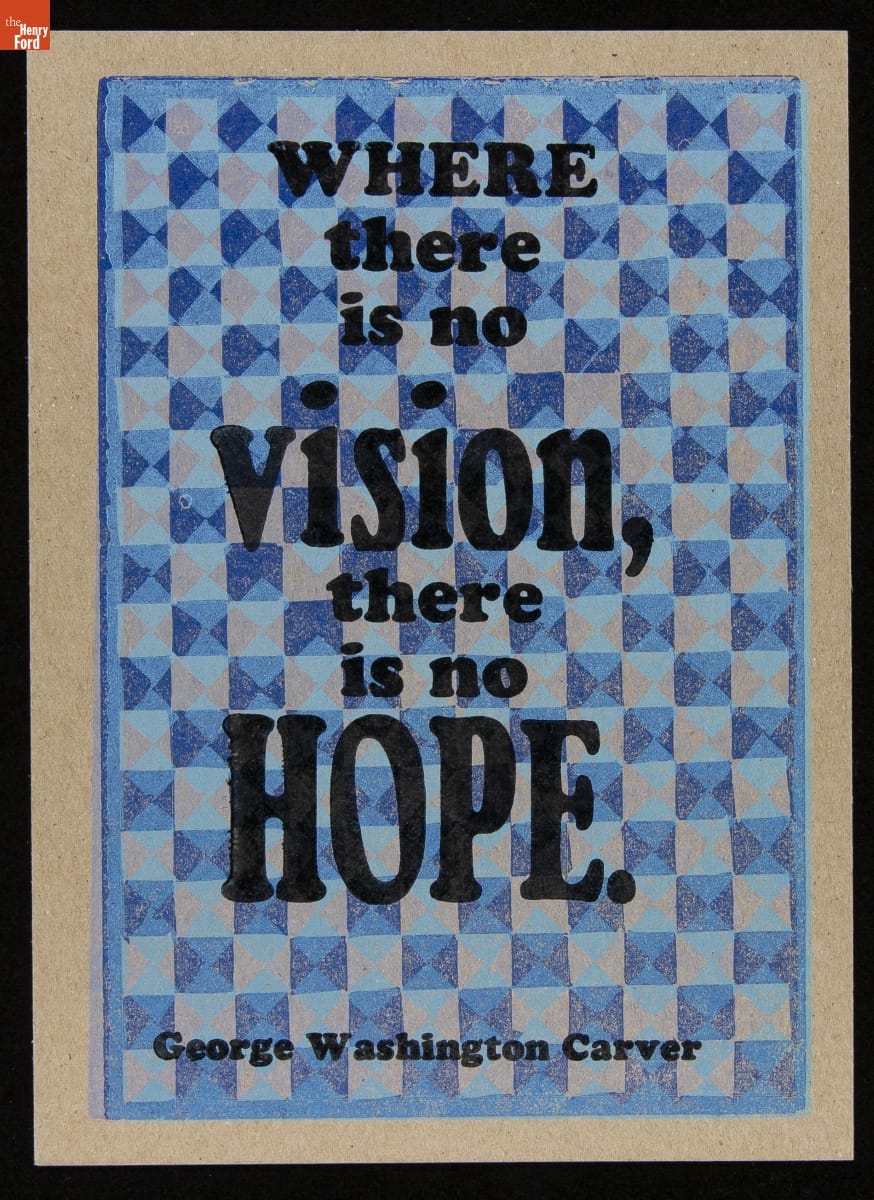
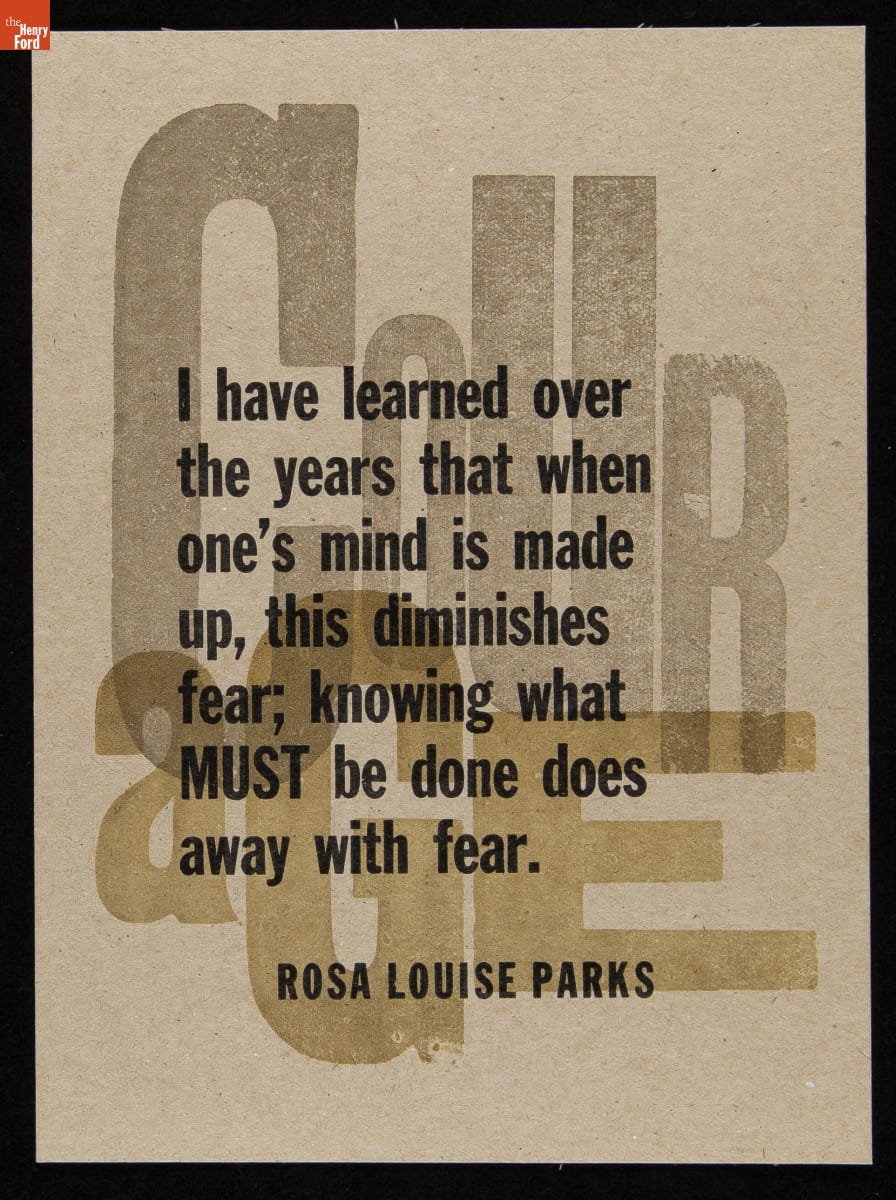
Amos Paul Kennedy Jr. has generously donated several prints to the collections of The Henry Ford. These examples feature quotes attributed to George Washington Carver and Rosa Parks—two advocates for change who are prominent in our collections. / THF626953 (top), THF626939 (bottom)
These letterpress prints are by Amos Paul Kennedy, Jr., who relocated to Michigan from the South in 1963 with his parents. In junior high, he experienced racism from teachers who presumed he was uneducated and poor because he was Black.
At the age of 40, Kennedy visited Colonial Williamsburg while on vacation with his family and was so enamored with the letterpress and bookbinding demonstrations being given by historical reenactors that he went home and began to take classes at a community print shop. His love for the medium grew to the point where he made the decision to leave his career as a corporate computer programmer at AT&T so that he could focus on printmaking full time.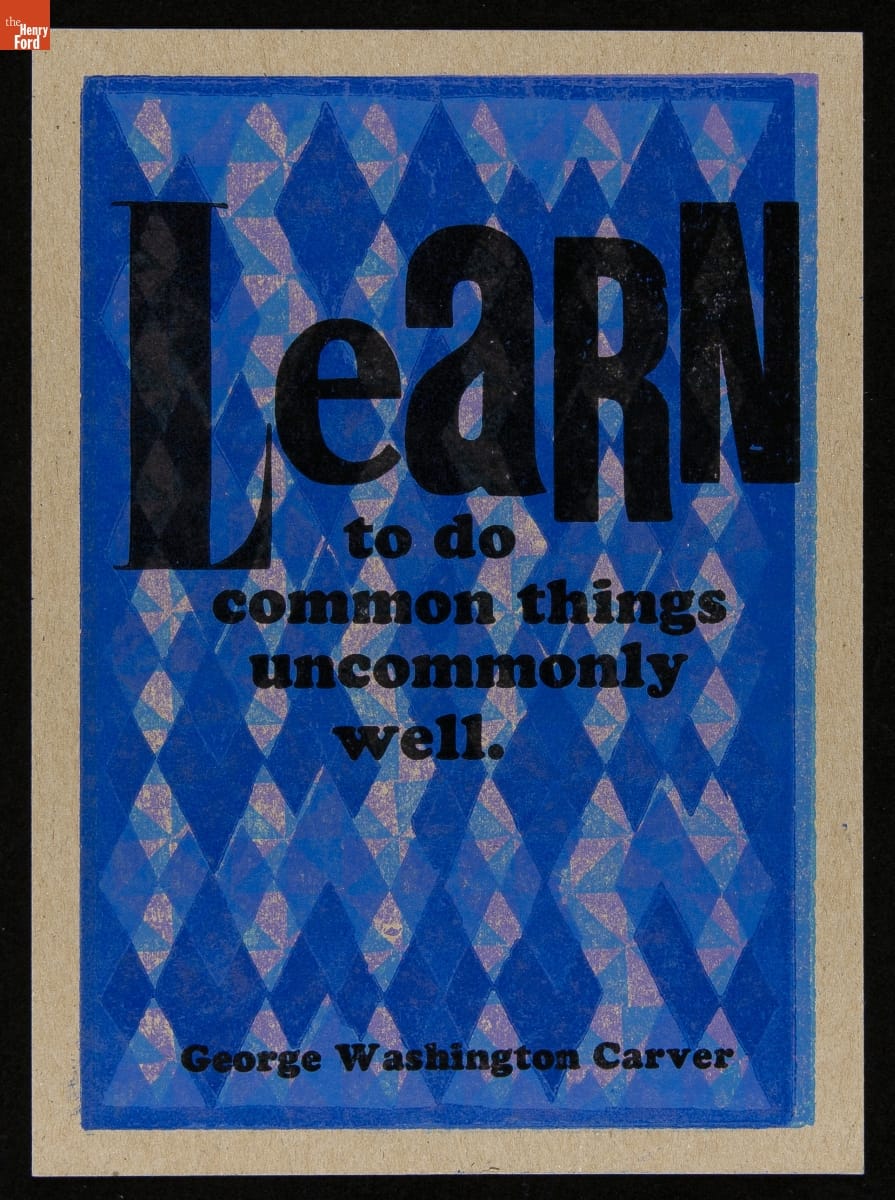
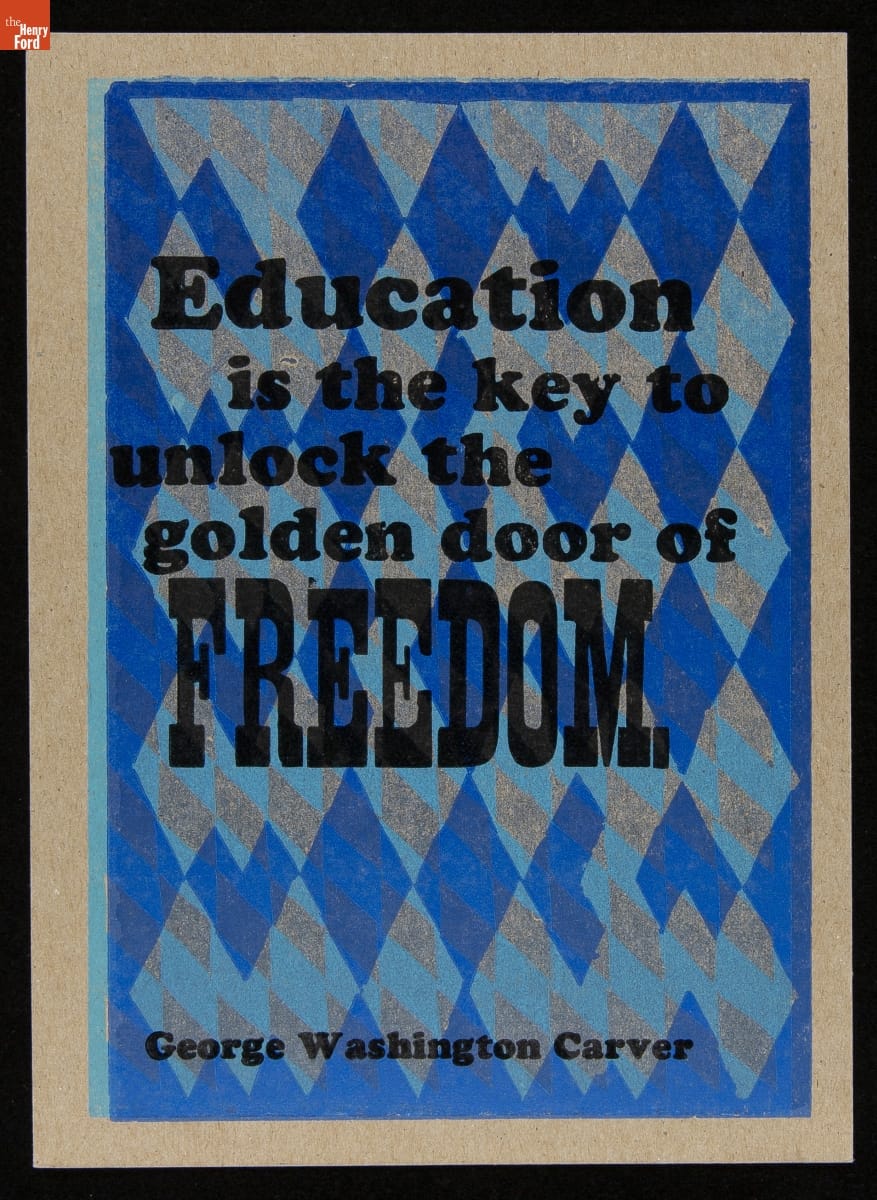
Letterpress prints by Amos Paul Kennedy, Jr./ THF626947 (top), THF626949 (bottom)
He went on to earn an MFA in Fine Arts and taught in university art programs. When Kennedy left academia, he adopted the historical role of an iterant printer, travelling through the American South to different print shops, learning about print media and developing his style over the course of many years. Kennedy sometimes describes himself as a “humble Negro printer” and wears bib overalls with a pink dress shirt. By doing this, Kennedy confronts people with their biases, causing them to question race, language use, and class. In 2013, Kennedy moved to Detroit, where he operates Kennedy Prints today.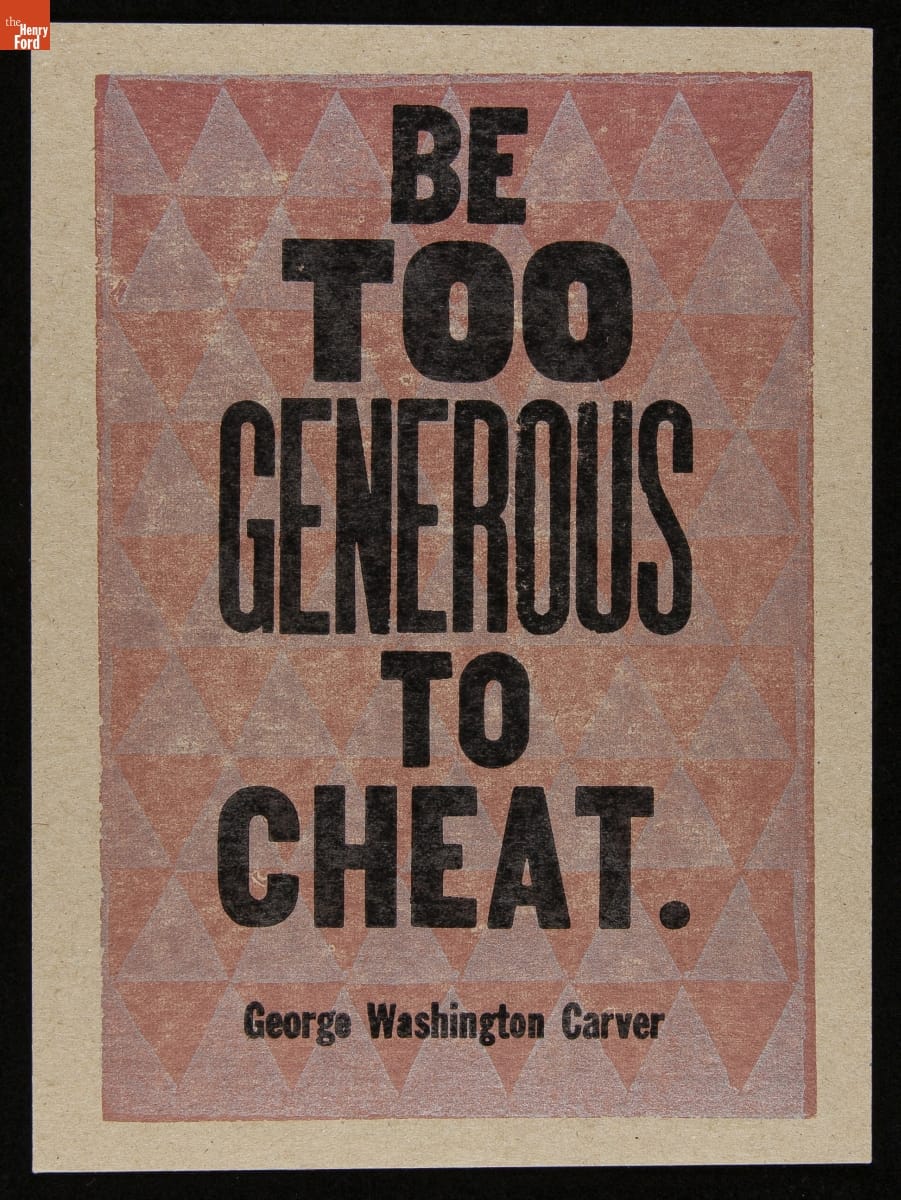

Letterpress prints by Amos Paul Kennedy, Jr. / THF626943 (top), THF626941 (bottom)
Kennedy is known for his prolific output of vibrant letterpress prints that address cultural biases and social justice issues. Many of his prints feature quotes by Black civil rights activists and abolitionists, scientists and innovators, and literary figures, as well as traditional African proverbs. In an interview with the Library of Congress in January 2020, Kennedy said:
“People sometimes classify me as a political artist, and I find that amusing because when I was young, I was told that everything you do is political […] I print the things that reflect the way that I want the world to be. I think that people who say they are not political in their work fail to recognize that ‘not being political’ is a political act.”
Kennedy refuses to call himself an artist and sells his work at affordable prices to make it more accessible. Thanks to the power of the multiple, Kennedy can use printmaking to spread messages of hope widely—to reflect exactly the type of world that he wants to live in.
Corita Kent
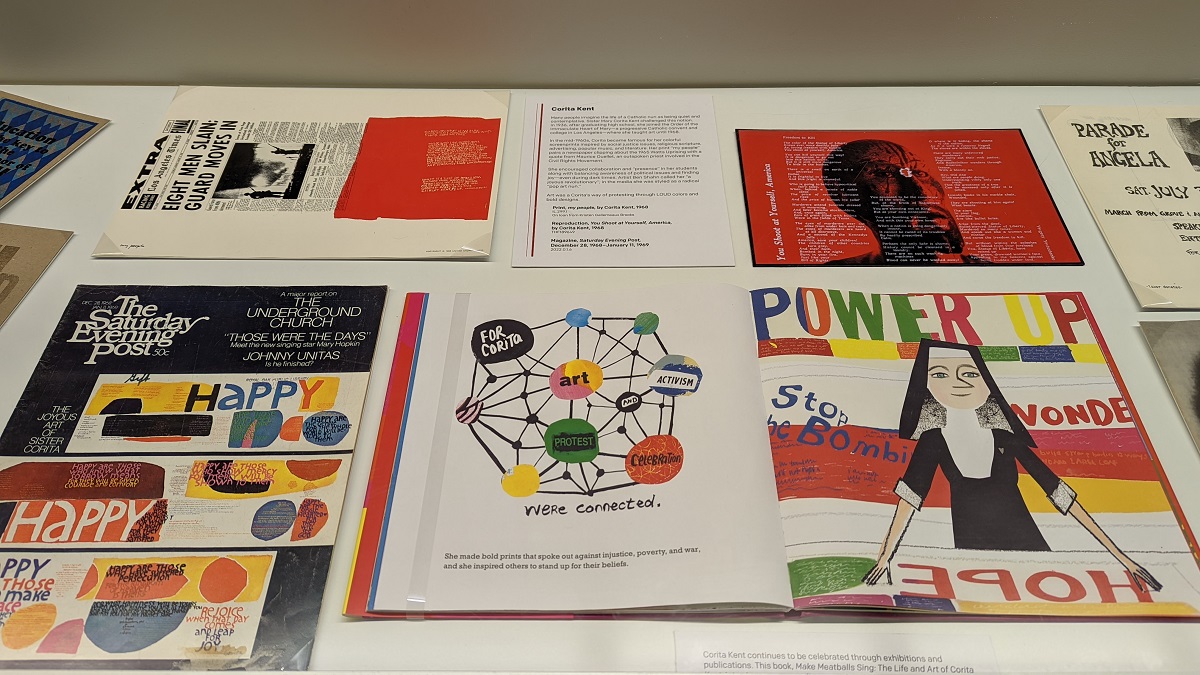
Photo by Kristen Gallerneaux
Many people imagine the life of a Catholic nun as quiet and contemplative. Sister Mary Corita Kent challenged this notion. In 1936, after graduating high school, she joined the Order of the Immaculate Heart of Mary—a progressive Catholic convent and college in Los Angeles—where she taught art until 1968.
In the mid-1960s, Corita became famous for her colorful screenprints inspired by social justice issues, religious scripture, advertising, popular music, and literature. Her most celebrated prints are text-heavy and vibrant, layering blocks of bright color and DayGlo ink with high-key photographic imagery and words that twist around the page.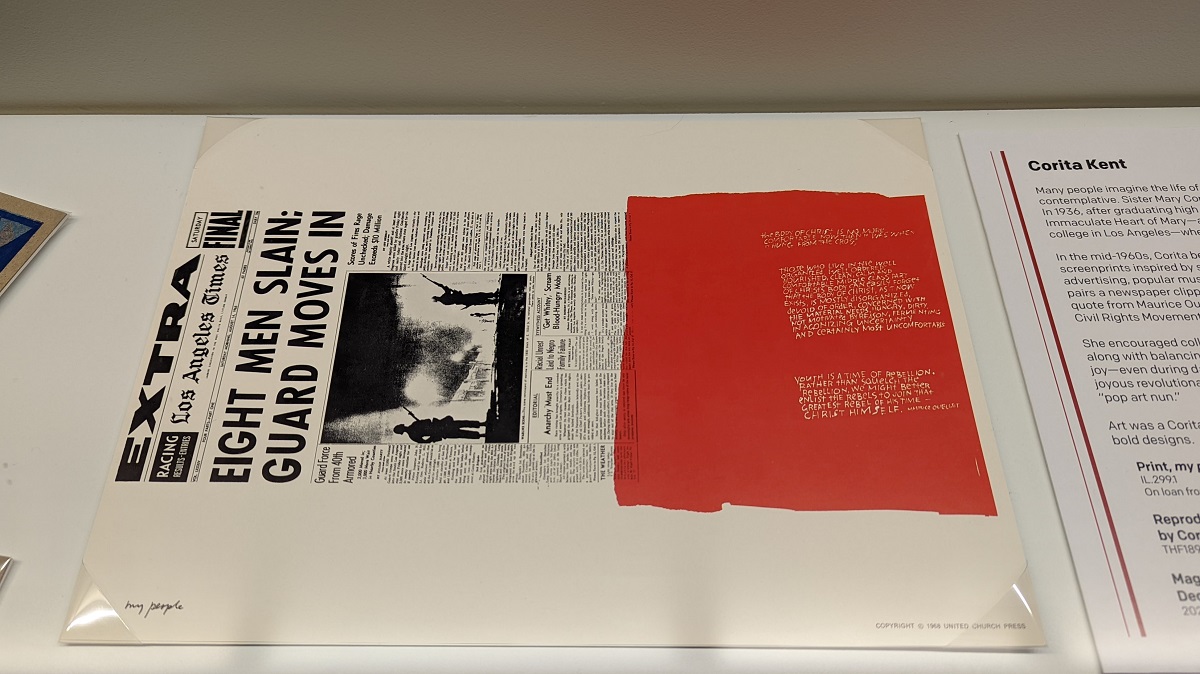
Detail of Quiet & Loud Protest exhibit with Corita Kent’s “my people” print. / Photo by Kristen Gallerneaux
Her print “my people” pairs a newspaper clipping about the 1965 Watts Uprising with a quote from Maurice Ouellet, an outspoken priest involved in the Civil Rights Movement in Selma, Alabama. Part of the quote Corita included reads: “Youth is a time of rebellion. Rather than squelch the rebellion, we might better enlist the rebels to join that greatest rebel of his time—Christ himself.” And in an oral history, Corita herself said: “I feel that the time for physically tearing things down is over. It’s over because as we stand and listen, we can hear it crumbling from within.”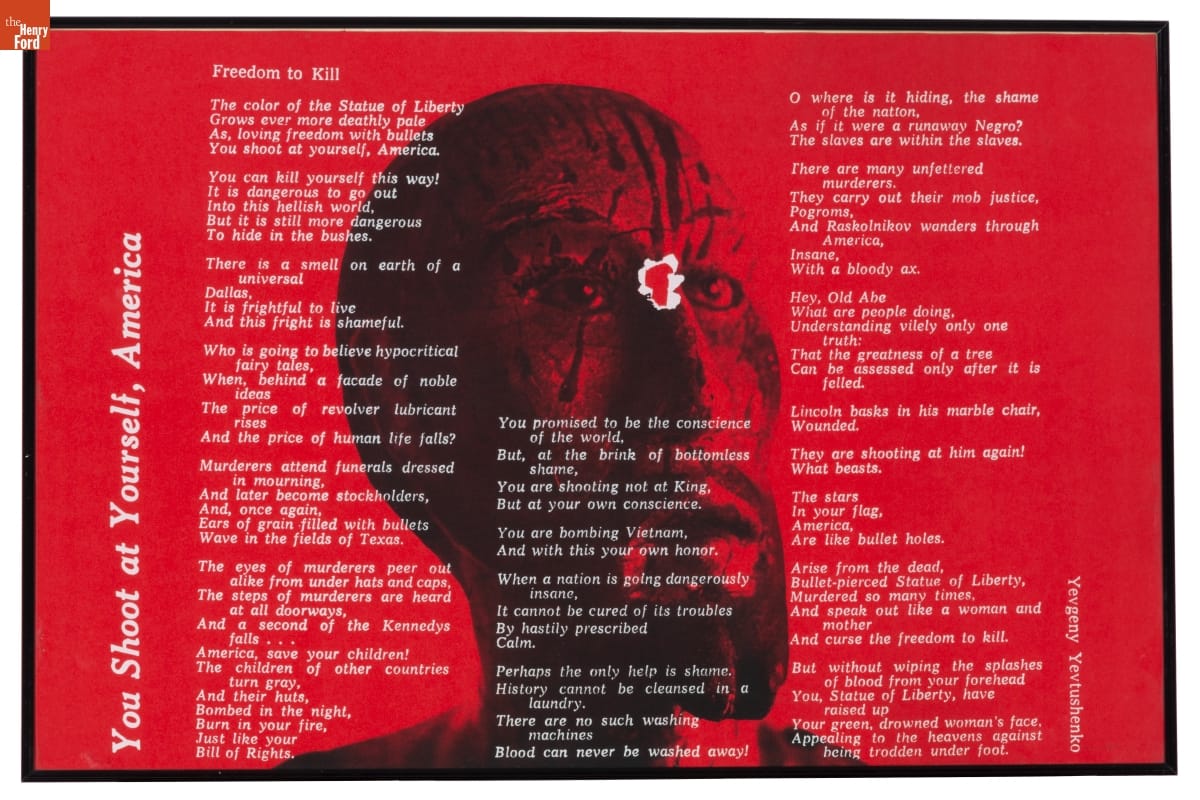
Corita Kent’s print “You Shoot at Yourself, America” was created in response to the 1968 assassination of Robert F. Kennedy. It features a poem by Yevgeny Aleksandrovich. / THF189649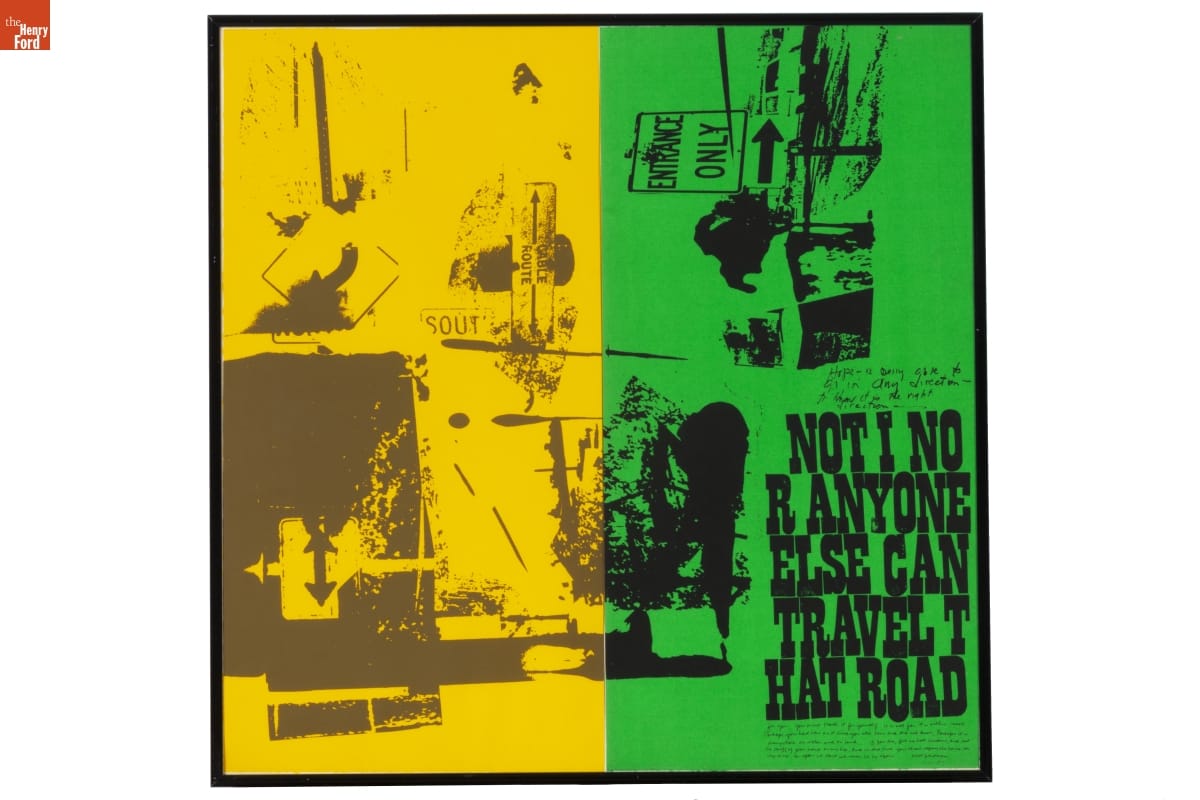
Corita Kent’s print “Road Signs (Part 1 & 2)” features text excerpted from Walt Whitman’s Leaves of Grass. / THF189650
Corita encouraged collaboration and “presence” among her students and encouraged them to balance awareness of political issues with finding joyful moments—even during dark times. Many important designers and creative thinkers visited her classroom, including Buckminster Fuller and Charles and Ray Eames. Artist Ben Shahn once called her “a joyous revolutionary” and in the media she was styled as a radical “pop art nun.”
Art was a Corita’s way of protesting through LOUD colors and bold designs.
During the height of Corita’s fame, the Catholic Church was reassessing many of its traditions, striving for unity and modernization under Vatican II. And yet not everyone agreed. In 1967, the Los Angeles archdiocese and Archbishop James McIntyre claimed the Immaculate Heart Community’s (IHC’s) approach to education was “communist” and referred to Corita’s work as being “blasphemous.” When the IHC sisters were ordered to end the liberating “renewal innovations” they had come to enjoy—or be asked to leave their teaching posts—many asked to be released from their vows and left in protest.
Corita’s decision to leave the order came a little sooner. In 1968, exhausted from an intense schedule and censorship from the church, Corita took a sabbatical. At the end of her time away, she left the Order and moved to Boston. There, she continued to receive commissions and to create art such as painting the Boston Gas Company’s tanks and designing the iconic “Love” postage stamp.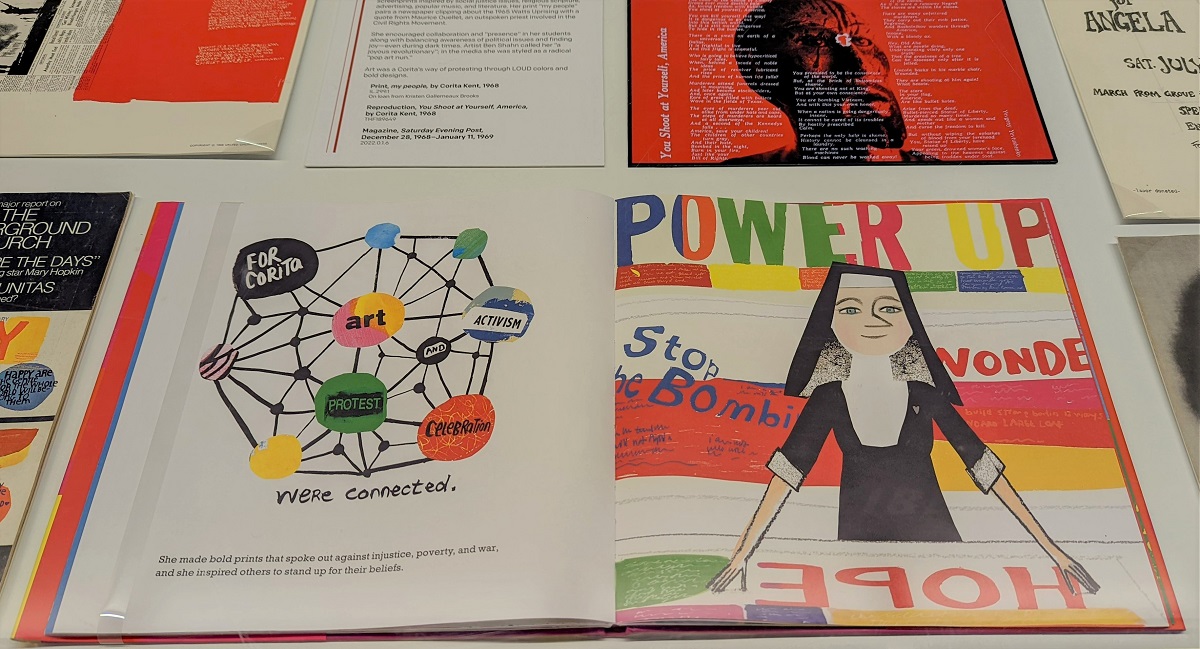
Corita Kent continues to be celebrated through exhibitions and publications. This book, Make Meatballs Sing: The Life and Art of Corita Kent, introduces young audiences to her story. / Photo by Kristen Gallerneaux
Angela Davis
Angela Davis is an activist, educator, and scholar who was a member of the Communist Party USA and the Black Panther Party. In 1970, Davis was placed on the FBI’s “Most Wanted” list. Guns registered to her name were used in a fatal attempt to free the Soledad Brothers during a courtroom trial. Davis was not present at the event. She fled police, fearing unfair treatment. After her capture, she spent 18 months in prison until being cleared of charges.
For some people, Davis is a controversial figure who believed in non-peaceful protest. To others, she is an inspiration as an outspoken supporter of women’s and civil rights, prison reform, and socialism. In recent years, she came out as lesbian and advocates for LGBTQ+ rights as well as those of Palestinian people.
The following artifacts relate to the impact of Angela Davis’s activism, past and present..jpg?sfvrsn=cc0a3601_2)
Vermont S. Galloway—a WWII veteran—made this “FBI Captures Angela” screenprint at Westside Press to advocate for Davis’s freedom. Galloway was fatally shot by the Los Angeles Police Department in 1972. / THF277084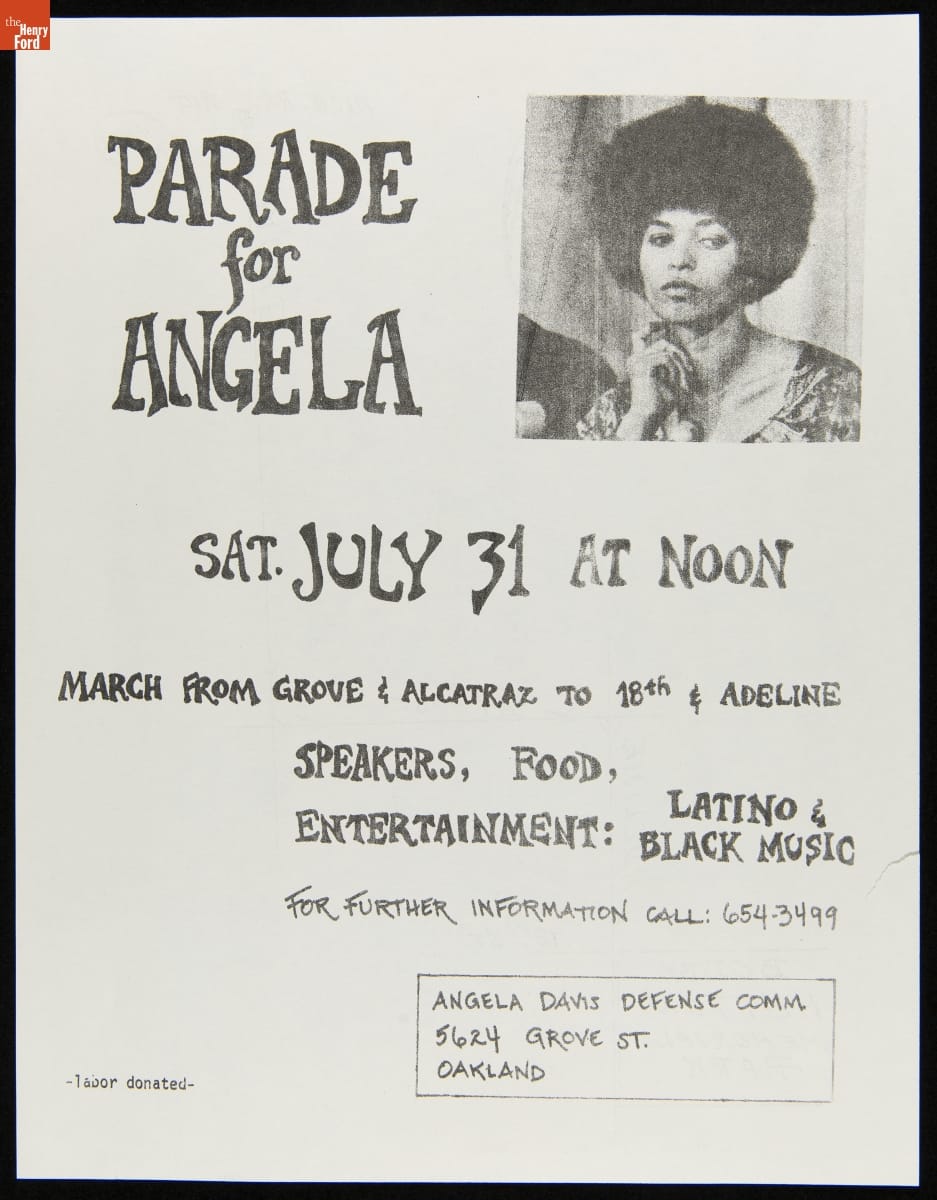
A parade flier documents the international “Free Angela” movement. The reverse side shows the planned route through Oakland, California. / THF627614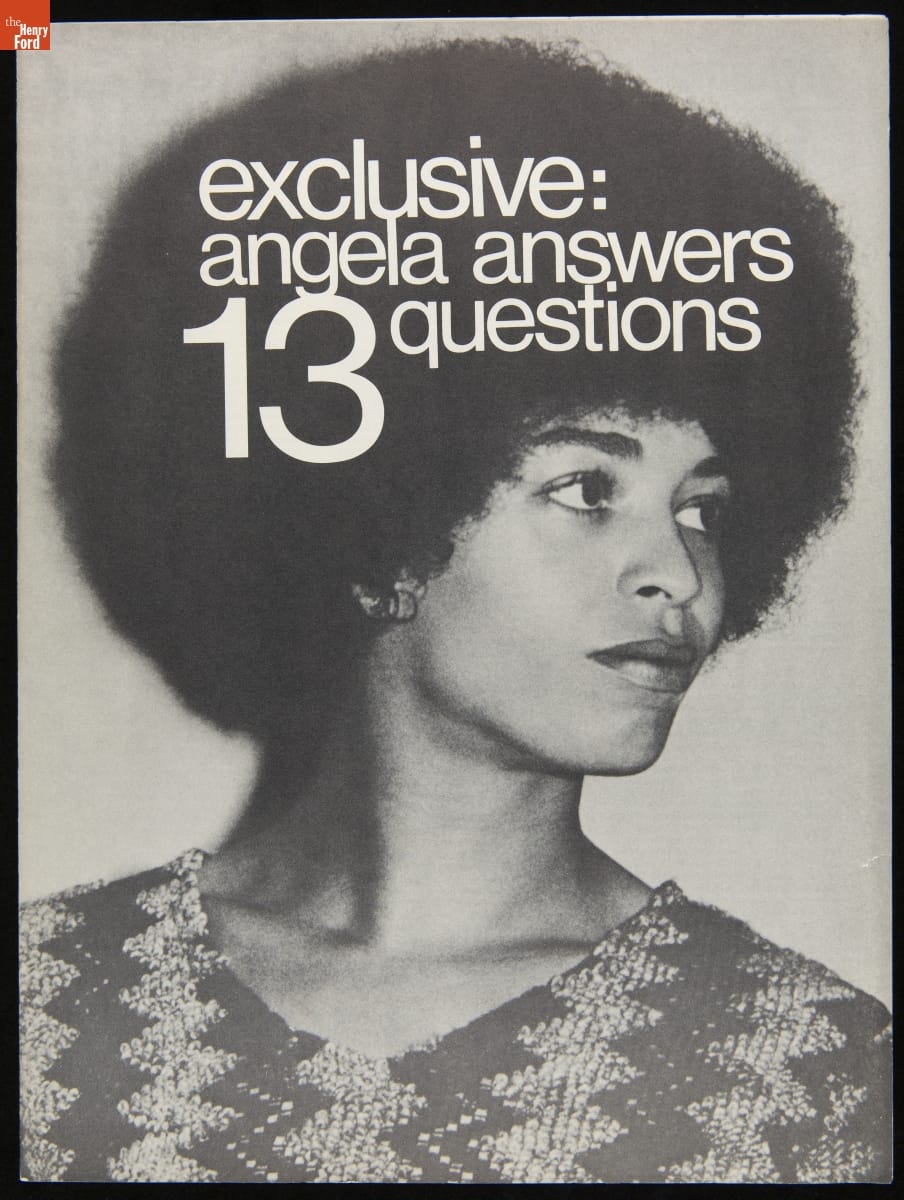
“13 Questions…” was the first interview with Davis while she was incarcerated. Her discussion with Joe Walker covers topics such as the surveillance of Black people, legal corruption, solidarity, and dismal prison conditions. / THF627594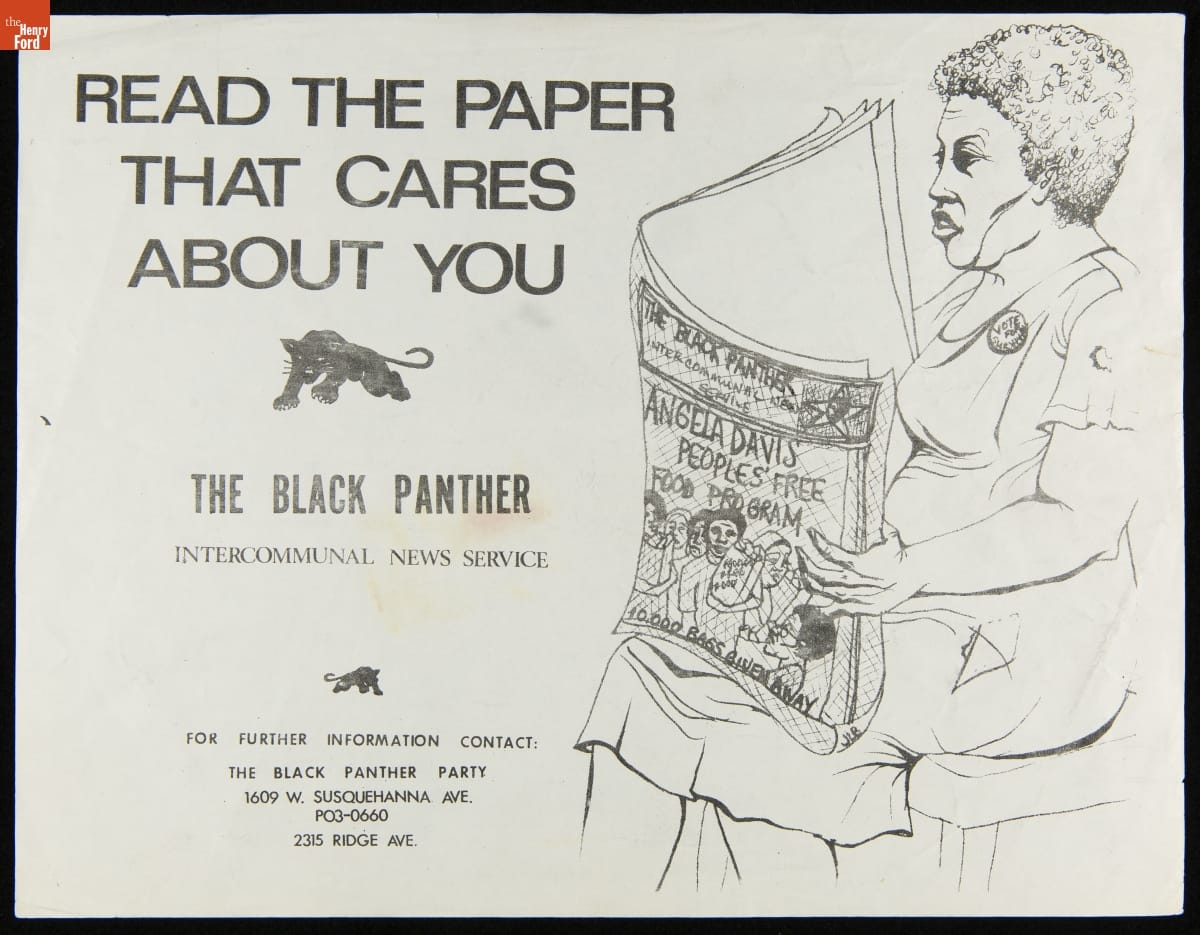
An illustration by Akinsanya Cambon advertises the Black Panther Party’s newspaper and the “Free Breakfast for Children Program,” using Davis’s name. / THF627598.jpg?sfvrsn=c40a3601_2)
Davis appears in a poster by Tongva artist Mer Young for the Amplifier Foundation. This poster shows the continued impact of Davis’s legacy and was created to encourage Black and Indigenous voting in the 2020 election. / THF626361
Listening to Our Community
In 2021, The Henry Ford began to seek community feedback for ways to update and improve our permanent exhibit With Liberty and Justice for All. This work is continuing in 2022.
Stories of movements, social innovators, and political history are difficult to fully capture in museum labels. There is always too much to tell in 100 words or less. To address this, throughout the display of this exhibit, we will be inviting several community partners to contribute their own labels, in their own voices, to foreground the issues they believe matter the most.
By the Curatorial Staff of The Henry Ford. Quiet & Loud Protest is on view in Henry Ford Museum of American Innovation until March 31, 2022.
Civil Rights, art, making, women's history, African American history, Henry Ford Museum, printing
1927 Plymouth Gasoline-Mechanical Locomotive

An unsung hero on our railroad: the 1927 Plymouth Gasoline-Mechanical Locomotive. / THF15920
When you think of the railroad locomotives in Greenfield Village, you probably picture one of our operating steam locomotives, or maybe the diesel-electric that occasionally steps in to pull passenger trains. You might even picture the Atlantic type steam locomotive inside the Detroit, Toledo & Milwaukee Roundhouse that you can walk underneath. But there’s another important member of our fleet that’s easy to overlook: our 1927 Plymouth Gasoline-Mechanical Locomotive.
Even as trucks and highways spread in the first half of the 20th century, industrial America largely still ran on rails. Manufacturers relied on railroads to bring in raw materials and ship out finished goods. The largest factories had extensive railyards filled with cars that needed to be shuttled around. Raw materials used by those factories were supplied by extractive enterprises like mines, quarries, and logging operations that operated internal railroads of their own. Clearly, there was a market for reliable, easy-to-operate locomotives that could be used on these private industrial railroads.
The J.D. Fate Company got into that market in 1914, building diesel and gasoline locomotives under the “Plymouth” brand (named for the company’s hometown of Plymouth, Ohio). Five years later, the firm combined with Root Brothers Company to form the Fate-Root-Heath Company. The newly-merged business manufactured brick and tile-making machinery, hardware and grinders, farm tractors, and—of course—light industrial locomotives.
What made Plymouth locomotives so simple and reliable? Our 1927 example is a gasoline-powered, mechanically driven machine. Its powertrain has more in common with the family car than with a steam locomotive. Steam locomotives burn coal in order to heat water and produce steam. That steam is fed into cylinders, where it pushes pistons that move rods that, in turn, move the driving wheels. Steam locomotives require specialized knowledge and skill to operate.

“Plymouth Gasoline Locomotives”—both the brand and the fuel are clear in this photo. / THF15919
Our Plymouth locomotive is powered by an inline six-cylinder gasoline engine. While it’s larger than what you’d find in a typical car (the Plymouth engine’s displacement is around 1,000 cubic inches), it operates under the same principle. Gasoline is fed into the cylinder and ignited by a spark. The resulting explosion pushes a piston that turns a crankshaft that, via a transmission, turns the driving wheels. And, like an automobile, the Plymouth’s transmission includes a clutch and a four-speed gearbox. If you can drive a car, then you can quickly learn to operate a Plymouth locomotive.
No two industrial railroads were the same, so Plymouth manufactured locomotives in multiple configurations. Track gauge—the width between the rails—was the most important consideration for a Plymouth customer. Standard gauge on American mainline railroads is 4 feet, 8 ½ inches—or 56 ½ total inches. But many industrial operations used less expensive narrow-gauge track. Plymouth built to suit anything from standard gauge down to 18 inches. Furthermore, Plymouth’s spring suspensions and short wheelbases were well suited to rough track with sharp curves.
Over the years, Plymouth also offered different engines and drivetrains. While our locomotive burned gasoline, other Plymouth engines used diesel fuel. (Note that these diesel Plymouths were still mechanically driven. They should not be confused with diesel-electric locomotives, which drive their wheels with electric motors.) In the mid-1940s, Plymouth introduced smooth-running torque converter fluid couplings as an improvement over its earlier mechanical clutches.
Industrial railroads may have been Plymouth’s main customers, but they weren’t the only ones. The company also sold locomotives to temporary railways—those built and used for construction projects like dams, bridges, and highways. Plymouth locomotives were practical, flexible machines that served an important niche market.

Our 1927 Plymouth locomotive earlier in its life, moving coal cars around Detroit’s Mistersky Power Plant, circa 1930. / THF113043
Our Plymouth locomotive was ordered by the Detroit Public Lighting Department—predecessor of today’s DTE Energy—in 1927 at a price of $6,800. It was delivered to the Mistersky Power Plant, a coal-fueled generating station located four miles southwest of downtown Detroit. The 14-ton locomotive spent the next four decades shuttling coal-filled hopper cars around the plant. The Plymouth was retired around 1970 and spent its last years at the plant sitting unused. It came to The Henry Ford in 1980. Today it’s used to move locomotives and cars around the roundhouse and yard in Greenfield Village—just the sort of job a Plymouth was designed to do.
As for the Fate-Root-Heath Company, it was acquired by Banner Industries in the 1960s and renamed Plymouth Locomotive Works. In 1997, Ohio Locomotive Crane bought the firm and, two years later, relocated it to Bucyrus, Ohio, not far from Plymouth. The company no longer builds new locomotives, but spare parts are made under license by other manufacturers. As for the work once done by Plymouth locomotives, while many shippers transitioned to trucks and highways, there are still industries that rely on rail transportation. Many of them now use motorized railcar movers—rubber-tired tractors with auxiliary flanged wheels and railroad couplers. These modern movers offer all the advantages of a Plymouth, but with greater flexibility.
There’s an interesting coda to our Plymouth’s story. Throughout its life at the Mistersky Plant, the locomotive was operated by engineer Charles Vaughn. Born and raised in Indiana, Vaughn moved to Detroit to work on the construction of the Mistersky facility. When that was done, he stayed on to operate the locomotive. Vaughn had no prior experience in railroading but, with an easy-to-run Plymouth, that wasn’t as issue. Mr. Vaughn remained at Mistersky for 45 years before retiring in 1972. In recognition of his long service, Vaughn’s co-workers presented him with the Plymouth’s bell and whistle as parting gifts. (The locomotive’s retirement came before Vaughn’s, so those safety appliances were no longer needed.)

The Plymouth’s original bell, once a retirement gift and now reunited with the locomotive. / THF188367
Charles Vaughn passed away in 1982, but his family held on to the bell and whistle. In 2013, Mr. Vaughn’s family decided to reunite the items with the locomotive. They gifted the bell and whistle to The Henry Ford, and we put them right back onto the Plymouth. We’d like to think Mr. Vaughn would’ve appreciated that thoughtful gesture by his descendants—and the fact that Greenfield Village visitors can still see (and hear) the little locomotive with which he spent so much of his career.
Matt Anderson is Curator of Transportation at The Henry Ford.
Additional Readings:
- Edison Dynamo Used on SS Columbia, 1880
- Electrical Connection
- Pioneers of Electricity
- Electricity? I’ll Take a Pound…
Michigan, Detroit, power, by Matt Anderson, railroads, Greenfield Village
The Deleted Slavery Passage from the Declaration of Independence
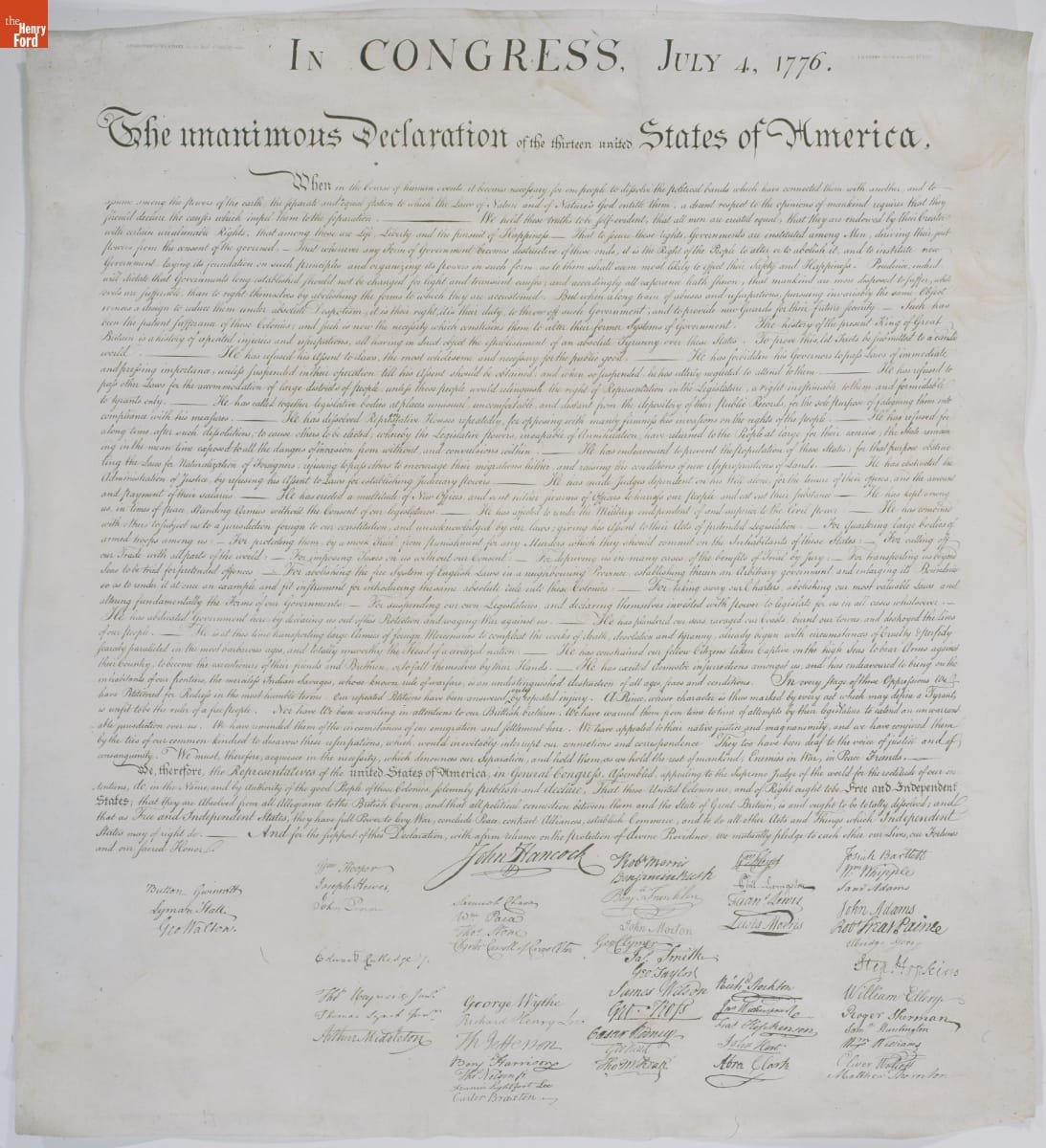 Engraved copy of the Declaration of Independence, one of only 200 copies commissioned by then-Secretary of State John Quincy Adams, printed 1823. / THF149572
Engraved copy of the Declaration of Independence, one of only 200 copies commissioned by then-Secretary of State John Quincy Adams, printed 1823. / THF149572
The Declaration of Independence, formally adopted on July 4, 1776, by members of the Second Continental Congress, was America’s manifesto against British tyranny. Thomas Jefferson, a Virginia delegate to the Continental Congress (and eventually a U.S. president), had been charged with composing the draft of this document.
Most people are familiar with these iconic lines from the Declaration of Independence:
…We hold these truths to be self-evident, that all men are created equal, that they are endowed by their Creator with certain unalienable Rights, that among these are Life, Liberty and the pursuit of Happiness…
This is the statement that is most memorable. It is the passage that has been invoked repeatedly throughout our history as a call to action, the passage that is still referenced today as the rationale for upholding people’s individual rights.
But there is much more to the Declaration of Independence than these lines. Further down, within a lengthier portion of the document, Jefferson’s initial draft included a scathing denouncement of slavery. If this passage had been retained, our country’s history might have been very different. But it was deleted.
Why did Jefferson—a slaveholder himself—write this passage denouncing slavery, why was it deleted, and what was the long-term impact of that decision?
The Slavery Passage
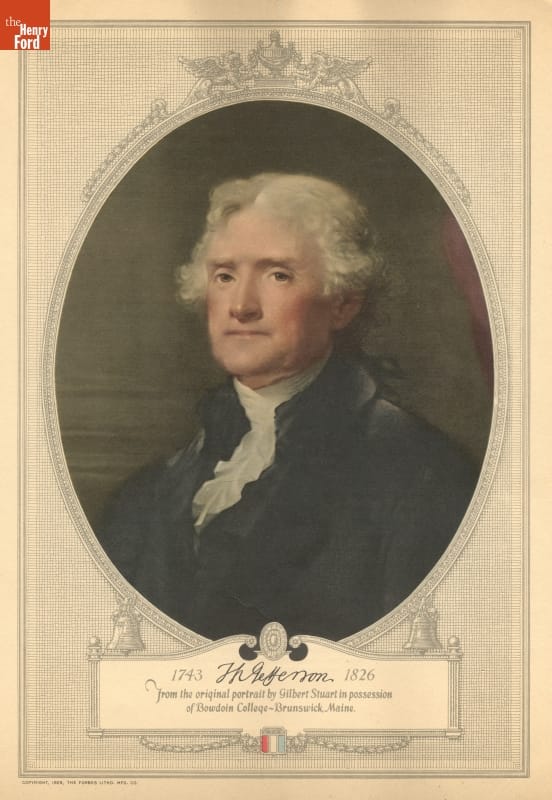
Print of Thomas Jefferson, 1929, based upon original 1805 portrait by Gilbert Stuart. / THF2295
The memorable first portion of the Declaration of Independence is full of soaring rhetoric derived from the Enlightenment ideals that Jefferson favored. The Enlightenment, an 18th-century European intellectual movement, stressed liberty and equality as natural human rights. The words in this first portion of the document were more philosophical and aspirational than the reality—and, indeed, they have lent themselves to reinterpretation and redefinition throughout our country’s history.
The later portion pertained to specific issues of the time. It contained a list of perceived wrongdoings against the colonists for which Jefferson blamed Great Britain’s King George III. These included the king’s repeatedly interfering with the colonists’ laws and ability to govern themselves; his placement of hostile troops in their midst; and his generally acting like a “tyrant” while violating Americans’ rights (for more on colonists’ mounting frustrations, see our post about the Boston Massacre). Nearly 30 charges were railed at King George III in Jefferson’s first draft, all intended to justify the colonists rebelling against him.
Included in this list was a 168-word passage condemning slavery as one of the many evils foisted upon the colonists by the British crown. Jefferson’s inclusion of this “evil” within this context was a tactically shrewd decision. It was easy to blame King George III for the institution of chattel slavery (that is, the buying and selling of people as property) with the rest of the “long train of abuses.” This was a key point of contention between Great Britain and the colonies.
The first part of the so-called “slavery passage” was aimed directly at the King:
He has waged cruel war against human nature itself, violating its most sacred rights of life and liberty in the persons of a distant people who never offended him, captivating & carrying them into slavery in another hemisphere or to incur miserable death in their transportation thither…
The second part of this passage alluded to a 1775 proclamation by British Lord Dunmore, which offered freedom to any enslaved person in the American colonies who volunteered to serve in the British army to fight against the American patriots:
…he is now exciting those very people to rise in arms among us, and to purchase that liberty of which he has deprived them, by murdering the people on whom he has obtruded them: thus paying off former crimes committed again the Liberties of one people, with crimes which he urges them to commit against the lives of another.
Lord Dunmore’s 1775 proclamation indeed inspired thousands of enslaved African Americans to seek liberty behind British lines. It also incensed American patriots. Including a direct reference to this, Jefferson knew, would further rally colonists behind the cause for independence and their commitment to rebellion.
Deleting the Passage
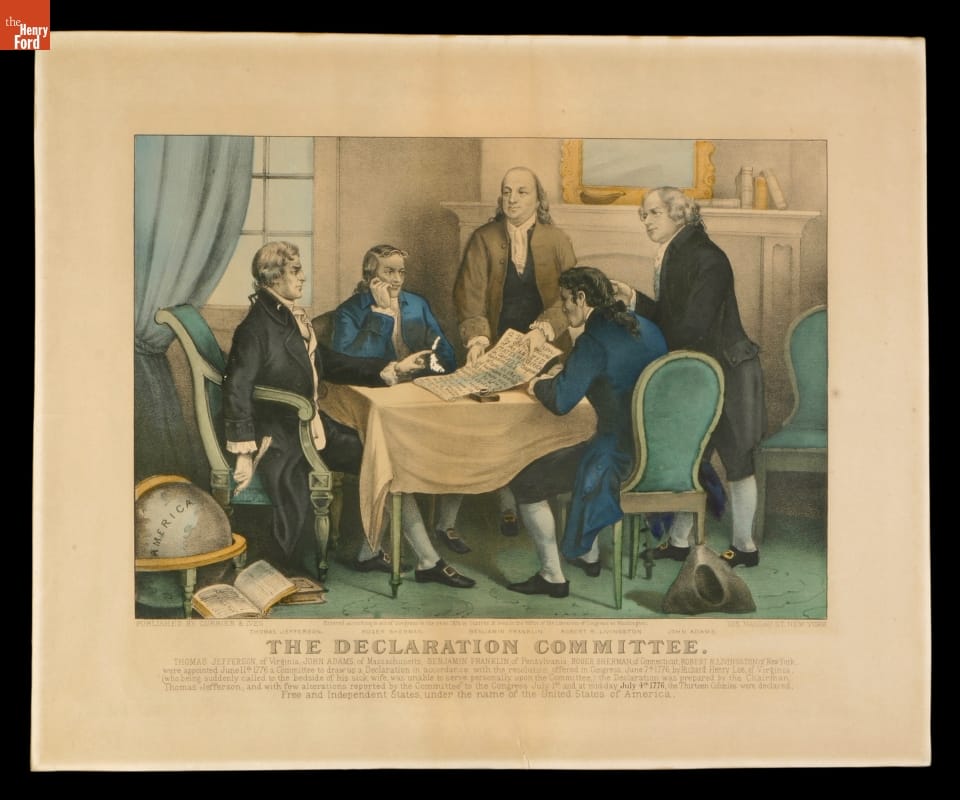
Engraving of members of the “Declaration Committee” reviewing Jefferson’s draft, Currier & Ives, 1876. In addition to Jefferson, this committee consisted of Benjamin Franklin, John Adams, Roger Sherman, and Robert Livingston. / THF97316
After four members of a small sub-committee reviewed Jefferson’s draft, the entire 56-member Second Continental Congress then debated its merits. The exact circumstances of this debate may never be known, as there is no written record of it. We do know, however, that during this debate, the slavery passage was removed.
Why did this occur?
The short answer is that too many delegates, and the colonies they represented, had a vested interest in perpetuating the institution of chattel slavery. Southern plantation owners insisted that they needed free labor to produce tobacco, cotton, and other cash crops for export. Northern shipping merchants depended upon the trans-Atlantic triangular trade of rum, sugar (generally in the form of molasses), and enslaved Africans. At the time, slavery existed in all 13 colonies, and at least one-third of the delegates to the Second Continental Congress (who would go on to become the signers of the Declaration of Independence) owned slaves themselves.
In addition to their own self-interest, the delegates had a larger intent in mind when they deleted the references to slavery in the document. They realized that this manifesto would inevitably lead to war. This document had to convince thousands of colonists to voluntarily risk their lives in a rebellion against the British. The grievances against King George III needed to be ironclad and compelling. They had to unify Americans from 13 very different colonies and from all walks of life. They needed to clearly distinguish friends from enemies. Removing the slavery passage, the delegates felt, helped clarify their arguments and achieve these goals.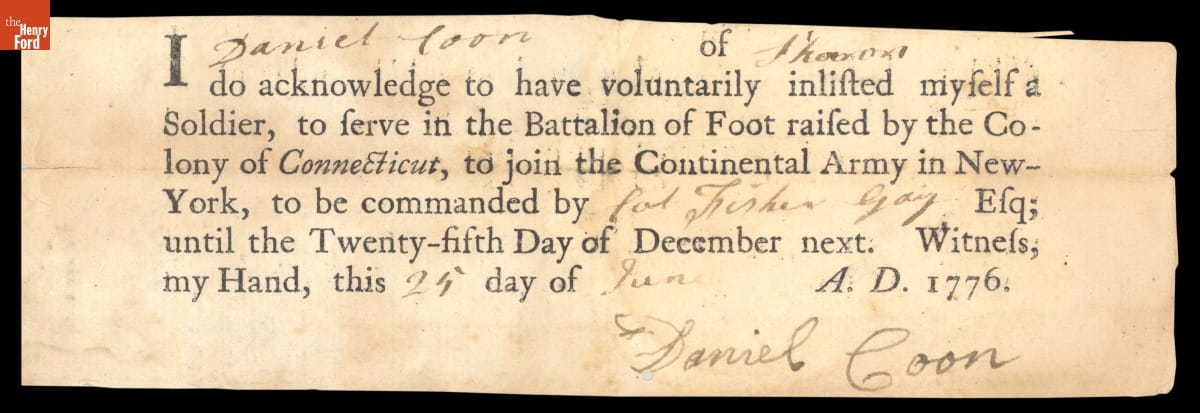
This Connecticut patriot enlisted in the Continental Army just before the Declaration of Independence was formally approved. / THF126080
Finally, there was also a prevailing belief at the time that slavery in America was on the wane—that the general emancipation of slaves was imminent and inevitable. Taking the path of least resistance, the delegates chose not to face this divisive issue head-on. Their delay tactic would not last for long, however, as the issue immediately emerged again during the drafting of the U.S. Constitution in 1787.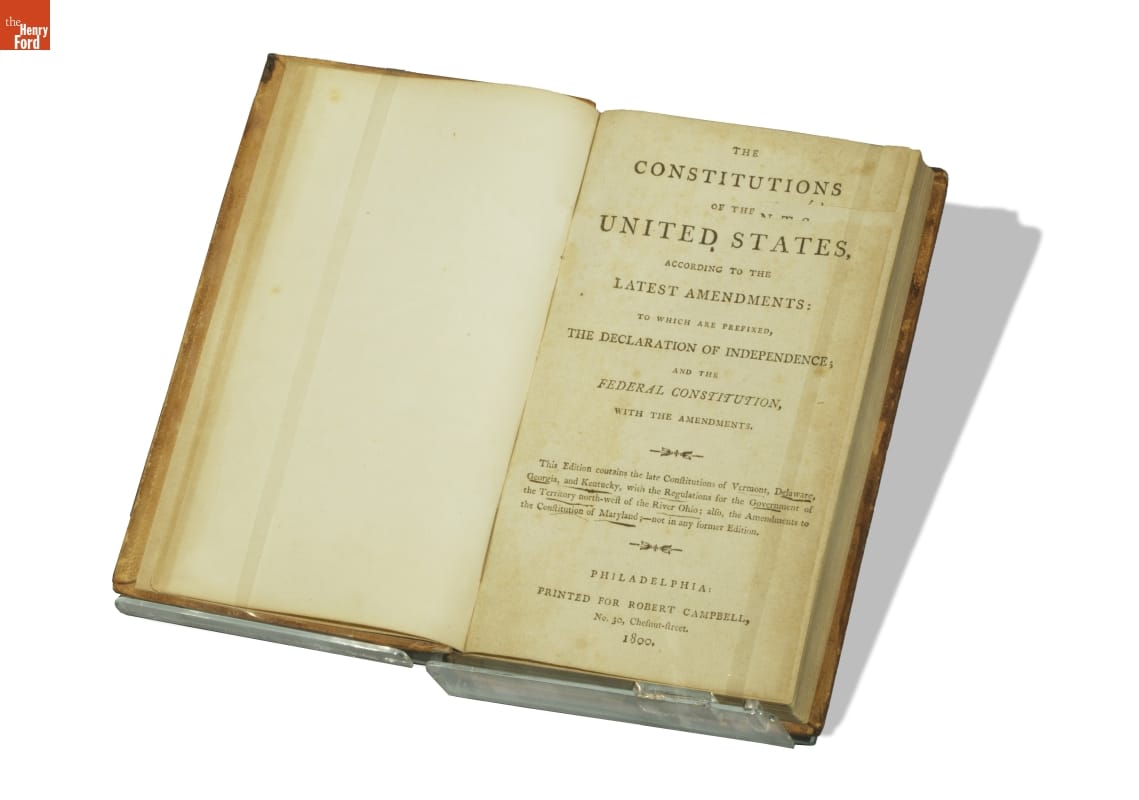
Copy of the U.S. Constitution, a rare survivor from 1800, including the text of the founding documents as well as the constitutions of the 15 then-existing states and the Northwest Ordinance, which regulated the Northwest Territory. / THF155864
In the end, the delegates replaced the deleted slavery clause with a passage that instead highlighted King George III’s incitement of “domestic insurrectionists among us”—a direct reference to the British stirring up, encouraging, and supporting warfare between colonists and Indigenous tribes:
He has excited domestic insurrections amongst us, and has endeavored to bring on the inhabitants of our frontiers, the merciless Indian Savages, whose known rule of warfare, is an undistinguished destruction of all ages, sexes and conditions.
This was a statement, the delegates believed, that the colonists could truly rally behind. They made no more changes after that.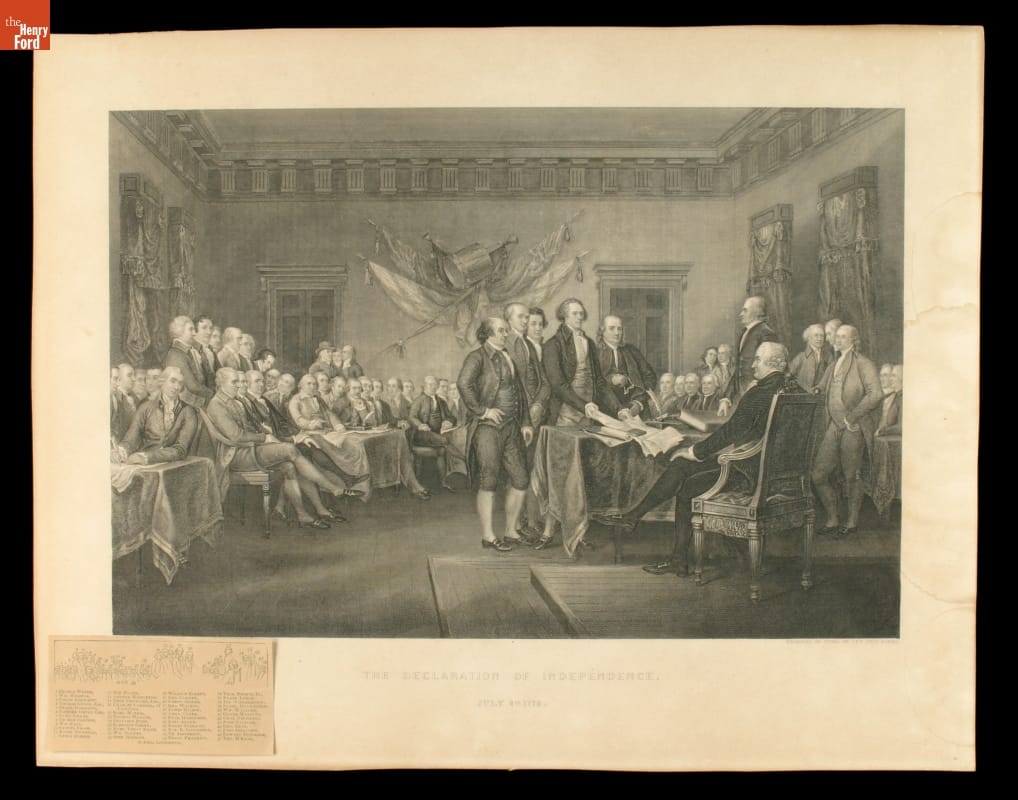
This engraving depicts the June 28, 1776, presentation of the draft of the Declaration of Independence from the five-member Declaration Committee to the entire Second Continental Congress. Engraving made about 1850 by J.F.E. Prud’homme, based upon an 1817 John Trumbull painting. / THF97322
And so, on the fourth day of July, 1776, with the adopted Declaration of Independence in hand, the thirteen American colonies formally declared their independence from Great Britain.
Thomas Jefferson quietly seethed about the changes to his draft of the document, especially the deletion of the slavery passage. He was, in fact, deeply conflicted about the institution of chattel slavery. He understood that his own livelihood depended upon its perpetuation and, over his lifetime, enslaved over 600 people (including his own children by enslaved woman Sally Hemings). At the same time, he bemoaned the existence of slavery and was continually frustrated that he could not extricate himself from its “deplorable entanglement.” As U.S. president in 1807, he passed significant legislation prohibiting the “importation of slaves to any port or place within the jurisdiction of the United States.” But he also suspected that Black people were inferior and supported the popular notion that newly emancipated slaves should leave the U.S. and resettle in Africa or the West Indies.
Impact of the Revised Passage
What the signers of the Declaration of Independence did not realize at the time was that instead of weakening or dying out completely, slavery would become more widespread, profitable, and entrenched in American society. They did not know that slavery would become the central defining problem that would lead to the bloody U.S. Civil War.
The decision to remove the slavery passage and replace it with a passage about “domestic insurrectionists” (i.e., Indigenous tribes) also left a long shadow over the definition of who was considered part of the new republic and who was not—in essence, defining who was an American and who was an outsider (African Americans, both enslaved and free, as well as Native Americans). It consequently ensured that systemic racism against these groups would become as foundational as the American ideal of “life, liberty, and the pursuit of happiness."
The deletion of Thomas Jefferson’s slavery passage in the Declaration of Independence had powerful and far-reaching consequences. Little did the Founding Fathers know that that we would still be feeling those reverberations today.
Donna R. Braden is Senior Curator and Curator of Public Life at The Henry Ford. This blog post is part of a series that sheds new light on stories told within the With Liberty & Justice for All exhibition in Henry Ford Museum of American Innovation.
Henry Ford Museum, presidents, African American history, by Donna R. Braden
Celebrating Lamy’s Diner
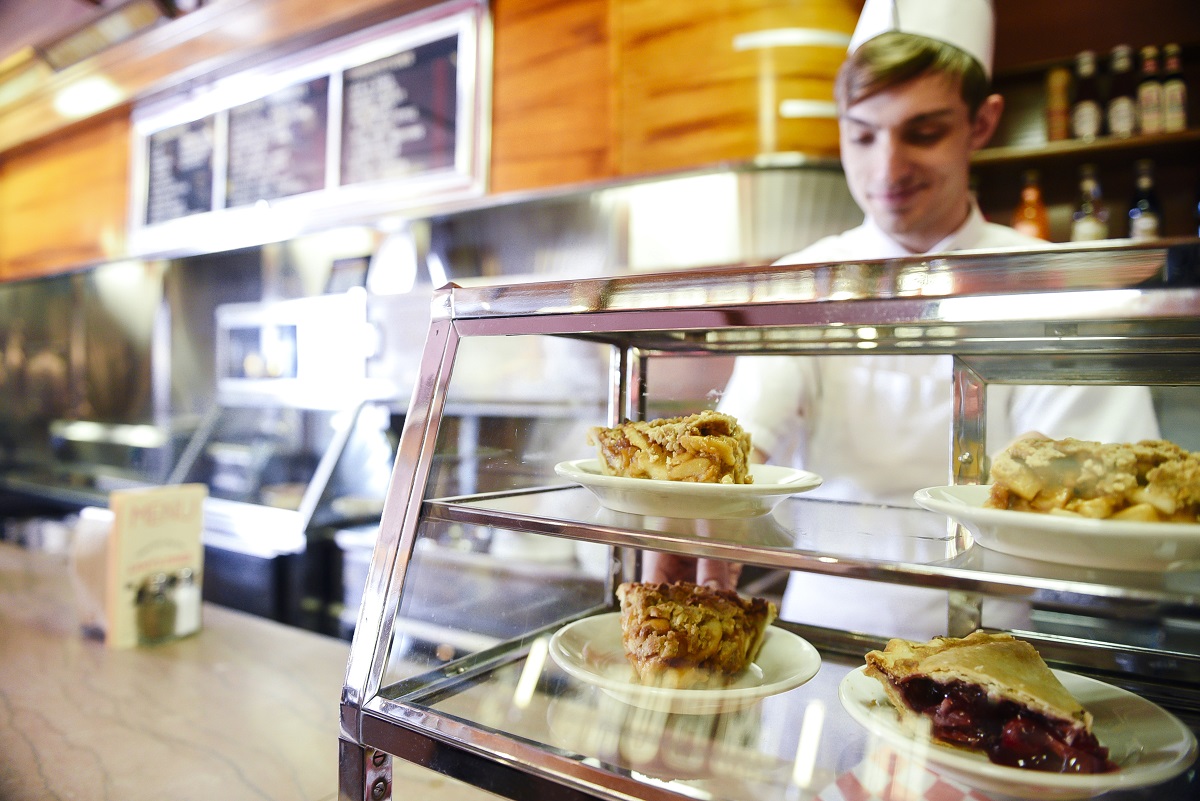 Photo by Emily Berger
Photo by Emily Berger
This month we are excited to reopen a guest favorite inside Henry Ford Museum of American Innovation: Lamy's Diner, a must-stop destination closed for almost two years during the COVID-19 pandemic. Operating as a restaurant inside the museum since 2012, Lamy’s provides members and guests an authentic 1940s diner experience, complete with chicken salad sandwiches and frappes. (And Toll House chocolate chip cookies, of course!)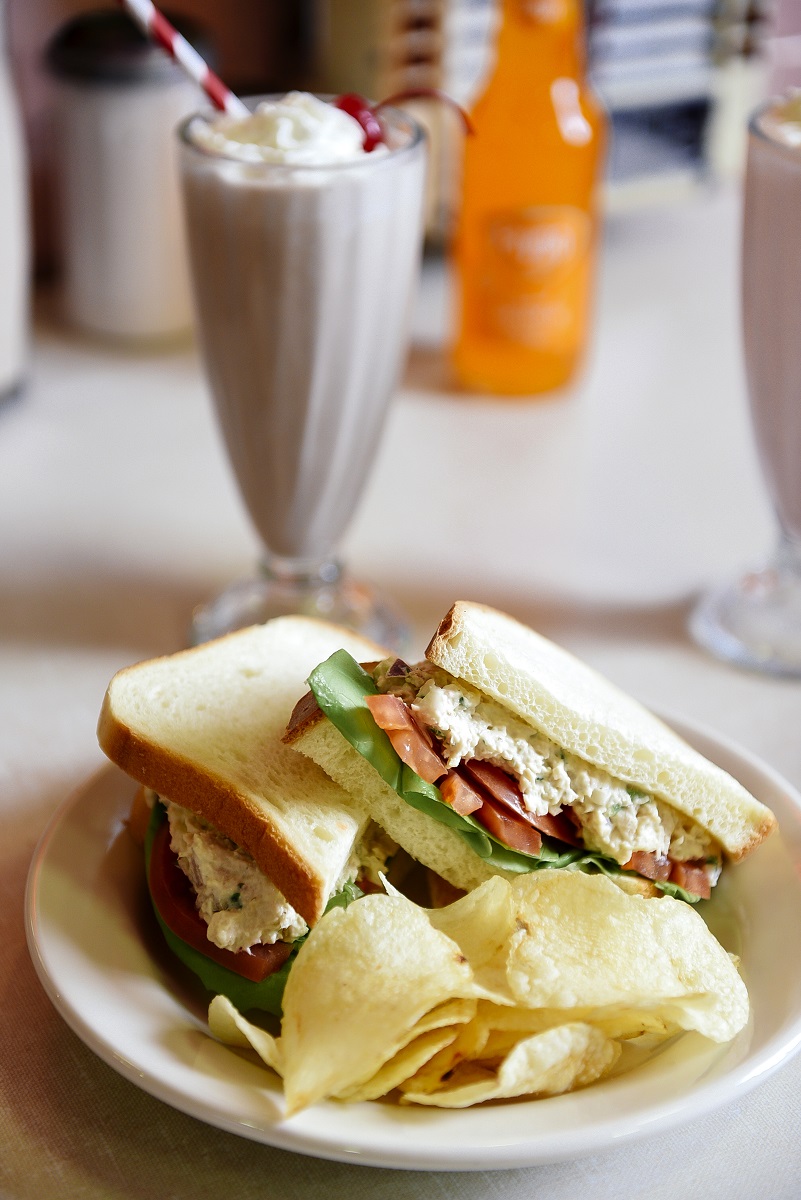
Photo by Emily Berger
In honor of Lamy’s reopening for daily dining, Eric Schilbe, Executive Sous Chef at The Henry Ford, shares two recipes that are crowd pleasers on the menu: tomato soup (an occasional special) and maple chicken salad. Try making these favorites at home, and then dig deeper into all-things Lamy’s in our Digital Collections.
Recipes
Lamy’s Tomato Soup
Makes about 4-5 bowls
Why we use this recipe:This is a very traditional tomato soup that has plenty of vegetable flavor and a touch of richness from the Parmesan cheese. (Psst! Don’t add the cheese until the very end!)
Ingredients
- 2T olive oil
- 1 large onion, diced
- 4 stalks small diced celery
- 2 carrots, chopped
- 1 bay leaf
- 1t dried basil
- 2 large cans diced tomato (plain – no seasoning)
- 1 cup half-and-half
- 1t pepper
- ¼ cup Parmesan cheese
Directions
- Cook the onions, carrots, and celery with oil in a stainless pot until completely tender.
- Add tomatoes, bay leaf, basil, and simmer about 30-40 minutes until completely cooked. (It should be a little darker than when you started.)
- Finish with half and half, Parmesan cheese, and pepper. Remove from heat.
- Using a blender, blend the soup until very smooth, and then serve immediately.
Chef’s Notes
- All canned tomatoes are not created equal! You may need to adjust with a little water or cook them down longer.
- Cook your vegetables until they are completely tender and falling apart—this will add richness to the flavor.
Lamy’s Maple Chicken Salad
Makes about 4-5 sandwiches
Why we use this recipe: Chicken salad can be such a simple recipe, but by adding maple syrup, a classic New England ingredient, and a touch of cumin, we set it apart from others.
Ingredients
- 2 large chicken breasts, cooked and cooled
- 4 stalks small diced celery
- ¼ minced red onion
- 1T yellow mustard
- 1T pure maple syrup
- ¼ cup mayonnaise
- 2T sour cream
- 1/4t cumin
- 1T fresh parsley, chopped fine
- 1t pepper
Directions
- Cook, cool, and pick the chicken. Place in a food processor and pulse until shredded fine.
- Add all other ingredients together and mix well.
- Let set, refrigerated, for 1-2 hours before serving.
Chef’s Notes
- During this era, the chicken was typically shredded very fine and simple ingredients were used. When making this at home, make sure the chicken is not overcooked and that it is very well shredded. This will make the salad moist and flavorful; you can always add a touch more mayonnaise.

Photo by Emily Berger
Dig Deeper: Lamy's Online
All About Lamy’s
- Plan Your Visit: Lamy’s Diner (find notes on visiting and hours)
- Lamy’s Diner, 1946 (check out the Lamy’s artifact page in our Digital Collections)
- Lamy’s: A Diner from the Golden Age (explore the history of Lamy’s on our blog)
- Lamy’s Gets a Makeover (2017) (learn about our 2017 updates to Lamy’s menu; note that additional changes have been made since)
- Lamy’s on TV: Mr. Coffee – The Henry Ford’s Innovation Nation
Diners, Drive-Ins... and Cookies
- Diners: An American Original (dig into the history of the diner on our blog)
- Dig Deeper: Owl Night Lunch Wagon (explore artifacts related to Greenfield Village’s own Owl Night Lunch Wagon)
- Inventing America’s Favorite Cookie (find out how America’s favorite cookie, the Toll House chocolate chip cookie, was born)
- Flipping Burgers into a Career (learn the story of Don Dunivent, who worked for White Castle from the 1920s through the 1950s)
- Dig Deeper: Lunch Wagons (check out artifacts related to lunch wagons in our Digital Collections)
More Historic Dining at The Henry Ford
- Creating the Eagle Tavern Dining Experience (go behind-the-scenes to learn how we developed the menu for Greenfield Village’s Eagle Tavern)
- Beyond the Peanut: Food Inspired by Carver (discover how agricultural scientist George Washington Carver’s own recipes provided inspiration for some of our recipes at A Taste of History and Plum Market Kitchen)
Lish Dorset is Marketing Manager, Non-Admission Products, and Eric Schilbe is Executive Sous Chef at The Henry Ford.
Additional Readings:
- Lamy's Diner
- Lamy's: A Diner from the Golden Age
- Lamy's Diner at Its Original Site in Marlborough, Massachusetts, circa 1946
- Diners: An American Original
COVID 19 impact, recipes, by Eric Schilbe, by Lish Dorset, food, Driving America, Henry Ford Museum, diners, restaurants
1920 Dayton-Wright RB-1 Airplane

The Dayton-Wright RB-1 is a dramatic presence in Heroes of the Sky. / THF39666
“Racing breeds innovation.” It’s a time-tested saying that we often associate with auto racing, where things like rear-view mirrors and disc brakes proved themselves on the track before making their way into production cars. But that line holds just as true for early airplane racing. The proof is in competition craft like the 1920 Dayton-Wright RB-1.
Above all else, the RB-1 was built for speed. Designers Howard M. Rinehart (the “R” in “RB-1”) and Milton C. Baumann (the “B”) designed the airplane specifically to compete in the 1920 Gordon Bennett Air Race in France. First staged in 1909, the Bennett race was the premier venue for showcasing the latest in aircraft design and aviation technology. The competitions were held annually through 1913, but World War I forced a pause. The 1920 Bennett race, held in Orléans and Étampes, France, marked the first (and, as it turned out, last) running after the wartime hiatus.
Rods and linkages moved flaps that changed the shape of the RB-1’s wing. / THF1463
Rinehart and Baumann gave the RB-1 several features—taken for granted today—that were absolutely cutting edge for the time. To start, it was a monoplane (single wing) design in an age when double wing biplanes dominated. The RB-1’s wing was cantilevered, meaning that it was entirely self-supporting via an internal framework. The wing didn’t require struts or cables to hold it in place. Both the wing and fuselage (the body of the plane) were made from laminated balsa wood covered with plywood and varnished linen. The designers equipped the RB-1’s wing with flaps on the front leading and rear trailing edges. Moving the flaps changed the wing’s camber—the shape of its curve. The flaps hung down during takeoffs and landings to produce maximum lift at low speeds, and they turned up flush with the wing during flight to reduce drag at high speeds.
Notice how the RB-1’s wing flaps and wheels move together. / THF169298, THF169299, THF169300
Rinehart and Baumann realized that the wheels and struts used in an airplane’s landing gear produced significant wind resistance. They solved that problem with a pair of retractable wheels that could be pulled up into the fuselage when the plane was in flight. The RB-1 is believed to have been the first land-based airplane to use retractable landing gear. (Some earlier floatplanes—airplanes equipped with pontoons for water-based operation—had auxiliary retractable wheels.) The RB-1’s wing flaps and wheels were interlocked. When the pilot turned a hand crank on the control panel, the flaps and wheels moved simultaneously—wheels and flaps up after takeoff, or wheels and flaps down for landing.
The pilot’s view—or lack thereof—from the RB-1’s cockpit. / THF15954
Rinehart and Baumann also gave the RB-1 an enclosed cockpit. This further reduced drag, but at a significant cost. The design left the pilot with absolutely no forward vision, and with only limited lateral vision through a set of portholes on either side of the fuselage. The pilot had to fly in a zigzag pattern to see what was ahead.
The RB-1’s specifications were as impressive for 1920 as its appearance. The plane was equipped with an inline six-cylinder, water-cooled engine capable of 250 horsepower. Top speed recorded in competition was 165 miles per hour, but observers at the time thought the RB-1 was capable of 190 or even 200 miles per hour. The airplane measured 22 feet, 6 inches long, with a wingspan of 23 feet, 3 inches. The plane measured 6 feet, 2 inches high at its tallest point. Range was estimated at 275 miles—though that would’ve been cut considerably when flying at top speed.
The Dayton-Wright Company of Dayton, Ohio, built the RB-1. Dayton-Wright had been founded by a group of Dayton-area investors in 1917. Orville Wright served as a consultant to the firm, and he lent it the use of his name, but beyond that Dayton-Wright had no connection to the Wright brothers or their earlier Wright Company. (Wilbur Wright died of typhoid fever in 1912, and Orville Wright largely retired from business a few years later.) General Motors purchased the Dayton-Wright Company in 1919.
Howard Rinehart demonstrates the strength of the RB-1’s cantilevered wing. / THF270970
The work of piloting the RB-1 in the Gordon Bennett Air Race fell to Howard Rinehart. He had learned to fly in 1914 and, by the time the RB-1 project came together, Rinehart’s resume included stints as an exhibition flyer, a flight instructor, and a test pilot. Rinehart was a capable and experienced pilot well suited for the demanding Bennett competition, and the RB-1 was as fine an airplane as one could wish in 1920. When Rinehart took off on race day, September 28, 1920, he was America’s best chance to take the Bennett Trophy back from French pilot Maurice Prevost, who’d won the 1913 contest. But, in the words of poet Robert Burns, “the best-laid schemes of mice and men go oft awry.”
Soon after Rinehart left the ground, the RB-1’s variable wing camber system gave him trouble. He could not get the wing flaps moved into racing position. And because the flaps were interconnected with the wheels, he couldn’t get the landing gear pulled completely into the fuselage either. To make things worse, Rinehart started having problems with the control rod. One of its connecting cables broke, and he found himself unable to turn the plane to the left. After about 20 minutes of struggle, Rinehart brought the RB-1 in for a landing. He touched down safely, but his chance for a victory was gone. Newspapers reported that “there were tears in the pilot’s eyes as he stepped from his machine.”
The Dayton-Wright RB-1, photographed in August 1920. / THF270958
In the RB-1’s defense, mechanical problems were common in racing airplanes of that era. For that matter, technical gremlins continue to haunt racing vehicles of all types to this day—it’s just the nature of the game. The RB-1 never raced again. But in the years to come, its innovative features became commonplace.
Following the disappointment in France, Milton Baumann presented the RB-1 to the University of Michigan, his alma mater. It’s possible that engineering students used the aircraft for hands-on experiments. The university gifted the airplane to The Henry Ford in 1940. Knowing that the RB-1 had been modified several times leading up to the Bennett race, and that students may have made further alterations, museum staff members were eager to return the airplane to its race-day configuration. They turned to Charles Kettering, then the general manager of General Motors’ Research Laboratories Division in Detroit, for advice. Gearheads know Kettering for automotive innovations like the electric starter and leaded gasoline. But he was also one of the Dayton-Wright Company’s founders in 1917, and he was involved in the RB-1 project in 1920.
Today visitors will find the Dayton-Wright RB-1 on display in Heroes of the Sky, where it anchors our collection of early record-breaking aircraft. It may not have won any prizes in 1920, but the RB-1 continues to win admiration from those who see it.
Matt Anderson is Curator of Transportation at The Henry Ford.
Additional Readings:
- 1917 Curtiss JN-4 “Canuck” Biplane
- Neil Armstrong: Reluctant Hero
- The 1929 Women’s “Powder Puff” Air Derby
- Getting into the Air: Alexander Graham Bell’s Aerial Experiment Association
aviators, racing, Heroes of the Sky, Henry Ford Museum, flying, engineering, design, by Matt Anderson, airplanes

